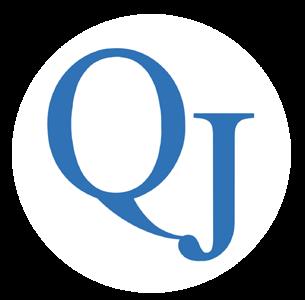

the journal
University staff Keith McNinch finds community and liberty in drag
Persona Shocktea Bubblegum brings creativity, connection, and colour to the Queen’s community
Kaliyha Dennis, Assistant News Editor
After years of planning events behind the scenes, Keith McNinch is stepping into the spotlight, this time, in heels.
As a Queen’s staff member and creative spirit for almost 10 years, McNinch, events and operations coordinator for the University, has found a new creative outlet through drag persona Shocktea Bubblegum.
In an interview with The Journal, McNinch explains he aims to blend storytelling through original music and a persona that reflects both personal transformation and community empowerment.
“Shocktea’s not just a drag queen, she’s the vessel for all this creative energy I’ve carried through my life,” McNinch said.
Originally from Chicago, McNinch has lived in Canada for over 21 years. McNinch and his husband were drawn to the slower pace of life, moving from Toronto event planning to growing lavender on his husband’s generational farm. Whenbefore McNinch
ultimately landed a job at Queen’s, something he described it as if as feeling like “the universe had aligned.”
Over time, McNinch became deeply connected to the Kingston community through local farmers, local Musicians and what he calls his “LGBTQ family.” He credits these overlapping communities, especially the LGBTQ+ community at Queen’s, with inspiring and encouraging his journey into drag.
Keith first experimented with drag during a Halloween costume contest when he debuted a younger version of Shock Tea Bubblegum, inspired by Princess Bubblegum from Adventure Time. While originally intended to be a lighthearted costume contest with his husband, McNinch described the feeling of the crowd when he won, sparking something within him which inspired him to keep building the character in the future.
When asked about his motivation to continue doing drag, Keith said he wants to inspire others to embrace self-expression in their own ways. He sees drag as a creative outlet that allows longburied feelings to surface, emotions that might not find space in day-today work life.
“So I’m doing that [drag] for myself, but I also think, through the character of Shocktea, I’m trying to do that for others,” he
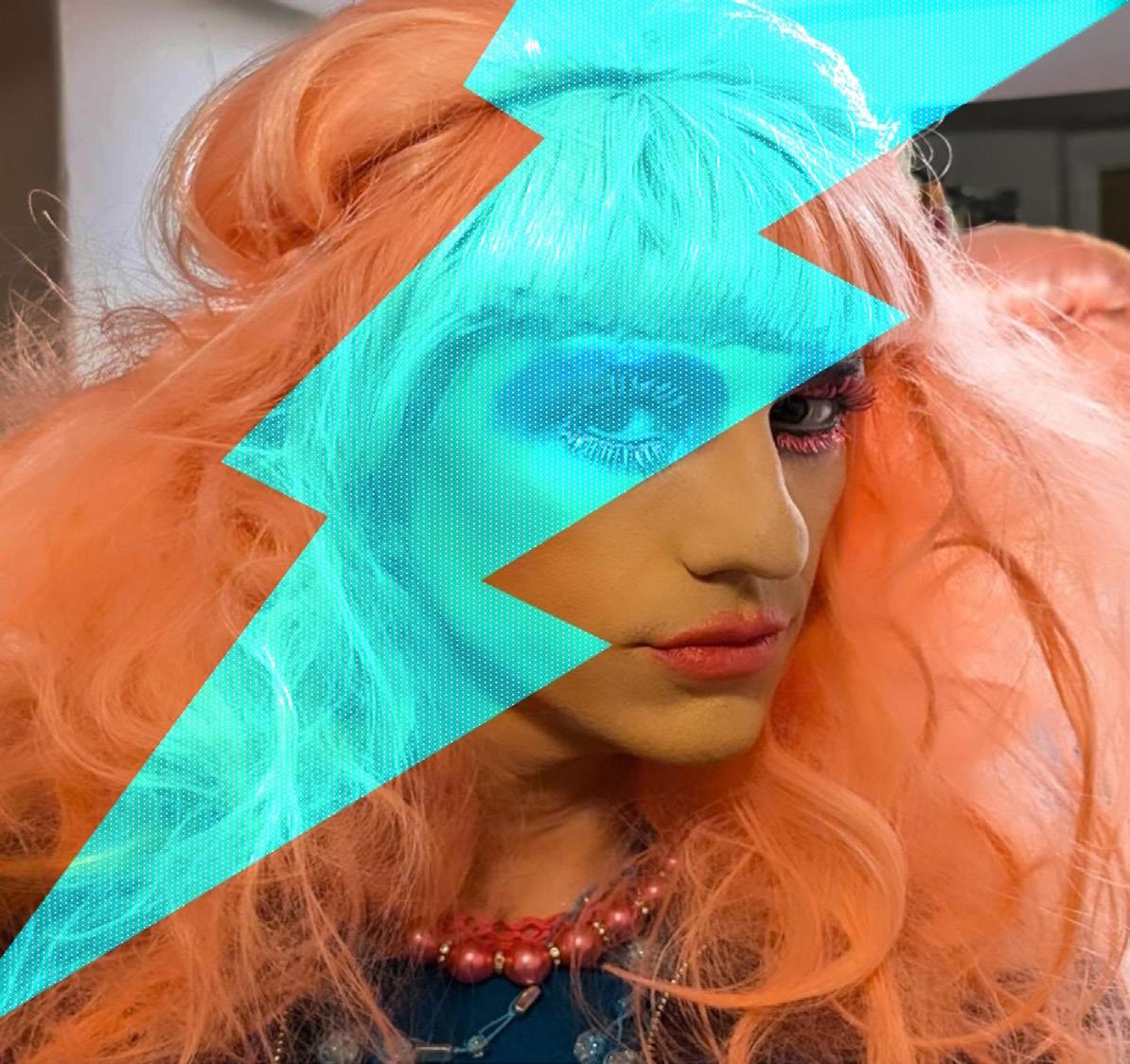
said. “Hopefully, Shocktea can open people up to new perspectives, and also take a look at their identity […] and try to enhance their vision of who they are.”
“It’s also funny how friends thatI’ve made all seem to have areas of interest that are intriguing to me, like physics, neuroscience, and religion. We had several areas in the show, it’s unifying, because it’s something that people from so many walks of life can enjoy, and even participate in if they want to, without having to make it their wholelife”
Now, McNinch is working on producing and performing original music, and he hopes to bring this work to Kingston stages, and eventually collaborate with the arts communityatQueen’s.
As for his advice forstudents or others who may be interested in exploring drag, Keith’sfirsttipwastosimply“hit up the thrift store” But more importantly, he emphasized the value of community, adding howifyougooutandlookforit, there’s many supportive and welcoming peopleinKingston.
“She came to my show in April at the Grad Club. It [The Drag Performance] was about to be cancelled, but there was Shelagh Rogers with my friends up in the front, and that was amazing.”
McNinch also spoke about how his friendships with professors and educators across different fields at Queen’s enriched his experience with drag.
Reflecting on whether he felt hesitant about sharing his drag persona with colleagues at Queen’s, McNinch admitted to feeling slightly nervous at first, but ultimately, he explained the experience was liberating. He attributes this sense of liberation comfort to the support he received from the Queen’s community, including colleagues who came to his drag performances, such as Shelagh Rogers, the University’s , Queens Universities’ own Chancellor.
“Kingston is so welcoming, and there’s already an infrastructure to put on shows. If you reach out and look for it, there are so many supportive people”
For those who may feel hesitant or afraid, he recommended attending the Open Stage Drag ShowatThe Grad Club, which takes place the first Wednesday of every month at 8 PM and is hosted by

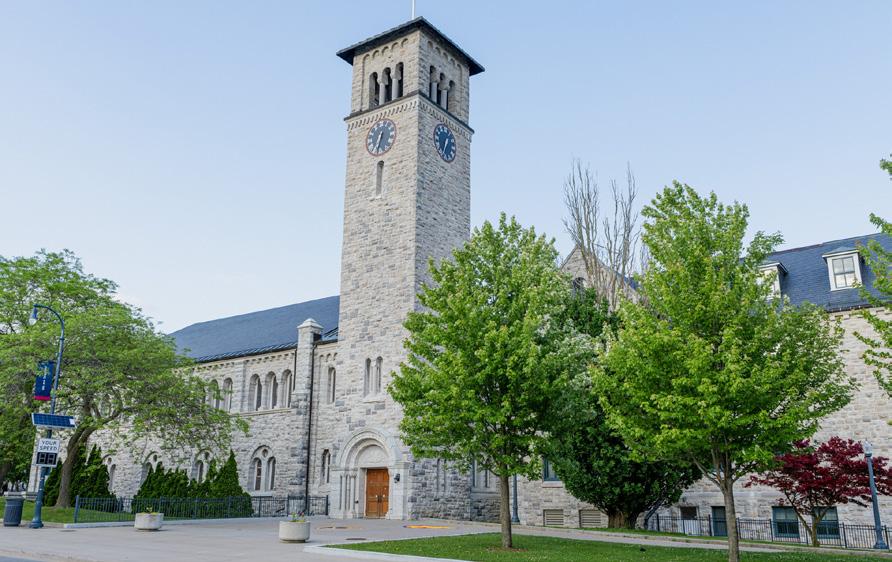
national and international ranking.
Jonathan Reilly, Senior News Editor
A mix of student-led projects and faculty research helped Queen’s climb to sixth globally in the 2025 Impact Rankings.

The Time’s Higher Education (THE) Impact Rankings are an annual ranking evaluating institutions around the world on their commitments to the 17 United Nations Sustainable Development Goals (SDGs). The analysis with this year’s list released on June 18 provides a ranking of individual SDGs, as well as an overall
The University hasparticipated in the Impact Rankings since its inception in 2020, with a group of staff and faculty comprising various initiatives and projects taking place at the University to be considered in its evaluation.
In the overall impact rankings, Queen’s rose from eighth worldwide in 2024 to sixth in the world this year. The University was most successful in SDG 2—Zero Hunger, placing first worldwide. Queens’ also placed second in


both SDG 14—Life Below Water and SDG 16—Peace, Justice, and Strong Institutions, while ranking in the top ten twice more, including a fourth-place finish in SDG 11— Sustainable Cities and Communities and a sixth-place finish in SDG 15— Life on Land.
With food security an issue for one in three Kingstonian families, with Graduate students being particularly effected, the University outlined some of its initiatives that landed it first in SDG 2—Zero Hunger.
In a Queen’s Gazette article, the University cited both faculty projects, including a research initiative aiming to develop natural alternatives to chemical fertilizers, as well as student led ones, such as Queen’s Vertical Farming Teams project creating Canada’s first

In an interview with The Journal, Principal and ViceChancellor Patrick Deane stressed that while success in the rankings can be beneficial for Queen’s overall reputation, the rankings’ importance goes beyond that.
“They are really helpful in that they provide you with a framework for interpreting the work that goes on in the University, and that means you can assess how much difference you’re making on those big global issues, and you can also organize yourself to be more effective,” Deane said.
Keith McNinch in his drag persona.
vertical farm designed by a postsecondary institution. , that grows plants without soil.
PHOTO SUPPLIED BY KEITH
PHOTO BY JASHAN DUA
ASUS President speaks to the qualities she hopes to see in the new dean
Jonathan Reilly Senior News Editor
The Dean search for the largest faculty at Queen’s has begun.
According to a recent announcement in the Queen’s Gazette, the University launched its search for a new Dean of the Faculty of Arts and Science (FAS) on June 4. Typically held for a five-year term, the position will be filled following a search process that’s expected to continue throughout the 2025–26 academic year.
The current Interim Dean, Bob Lemieux, was appointed after the resignation of former Dean,
Queen’s launches search for new Arts & Science dean
Barbara Crow, in 2024. Lemieux has been serving a two-year term, set to finish at the end of the current academic year.
The committee, chaired by Provost and Vice-Principal (Academic), Matthew Evans, includes 16 other members—faculty, administrators, and two students, including a Graduate student representative, who will all take part in the decision-making process. In a statement to The Journal, the University explained that additional opportunities for feedback will be available to those not on the committee, including through an online survey.
“In addition, the firm assisting with the search will be working directly with the student representatives on the committee to determine the best way to ensure the opinions and voices of students are reflected
Faculty push back on Dean search
Lack of committee representation leads to multiple letters to the Principal
Jonathan Reilly
Senior News Editor
Faculty members take issue with ongoing search committees for deans in letters to the principal.
Individuals from two faculties, including the Smith School of Business and the Faculty of Arts and Science (FAS), have written letters to Principal Patrick Deane raising issues with the composition, specifically in relation to faculty representation, of their respective dean search committees.
In a June 16 letter, over 50 professors from across the Faculty of Arts and Science criticized the advisory committees compostion to find their next Dean, noting only one member of the 16-person committee is a non-administrative faculty member. This means
Staff raise concerns about risks to programs, course delivery, and consultation
Jonathan Reilly Senior News Editor
With Arts enrolment shrinking, University Senators push for early input at Senate and analysis to guide future seat reallocations.
Following a motion approved in
in the overall process,” the University wrote.
Ivana Drinziu, President of the Arts & Science Undergraduate Society (ASUS), is one of two students on the panel. She said the next dean should be someone with integrity, financial acumen, and the patience to build trust with students and departments.
“Leadership-wise, I would say integrity, and [someone who has a] sort of financially acumen. A little bit of knowledge in that area [is important],” Drinziu said in an interview with The Journal. “They should be a strong communicator, try to build trust across departments and student groups, and they should probably prioritize collaborative leadership rather than top-down decision making.”
In regard to the faculty’s recent budget challenges, including
process
faculty without administrative titles make up 6.5 per cent of the committee. Professors wrote that even counting department heads, faculty outside the administration comprise less than 20 per cent of the committee.
Faculty members argued the committee’s makeup violates the spirit of the University’s Senate policies, which highlight the “normal desirability” of having a majority of the committee drawn from the faculty concerned.
In an interview with The Journal, Margaret Pappano—an English professor who signed the letter and assisted in its writing—explained this wasn’t the first time faculty have taken issue with the dean search. She explained that while Senate has created a committee to establish a new dean selection process, the proposed changes were sent back twice for not addressing their concerns.
“Senate is a sluggish, nonreactive body. It’s more likely to pass things than not, but it didn’t pass this twice, and that’s really significant because the problem with the lack of faculty representation wasn’t adequately addressed,” Pappano said.
April’s Senate, Queen’s University is shifting 300 enrolment seats from the Bachelor of Arts (BA) program into other degree plans for the 2026–27 academic year—a move that has sparked debate within the Senate.
The reallocation, discussed again at the May 15 Senate when Assistant Professor in the Department of Geography and Planning, Dan Cohen, brought forward two motions in response, reflecting broader concerns about the future of the BA program and the University’s enrolment priorities.
The change was first introduced
ArtSci set to spend $35 million over budget during the 2025-26 school year, Drinziu reiterated the importance of financial acumen in the dean’s role.
“Experience in strategic budget management, risk management, and institutional restructuring will be beneficial. It was for the previous dean [Lemeiux], and I’m assuming that’s where the faculty is looking to take us as well,” Drinziu said.
Speaking about the search process, Drinziu believes there are strategies in place to ensure the student voice is reflected. However, she acknowledged that many students may still feel disconnected from the process, adding that this is where her role as ASUS president becomes important.
“I’m an elected student leader, and I think my most notable job description is advocacy for our
students and making sure that their opinions, their feedback, their concerns, and their comments, are meaningfully considered in the search,” Drinziu said.
As for how ASUS plans to collect feedback, Drinziu explained while they’re still planning exactly what it will look like, they’ve discussed the possibility of town halls, surveys, and focus groups. While also planning to take advantage of their website and social media to promote feedback, she stressed her hope to make her email as available as possible to hear directly from students.
The Office of the Principal sent out an email on May 4 to FAS students, faculty, and staff to inform individuals of the search and similarly encourage feedback to the Provost’s email.
Pappano later stressed why she feels faculty representation is important on the committee.
“Somebody who has spent a lot of time in administration can lose touch, I think, with the academic perogative and can begin to focus solely on financial and sometimes on governance structures themselves that are disconnected from, you know, academics,” Pappano said.
Instead of an appointment from the principal, Pappano suggests using the FAS Board as a way of appointing committee members.
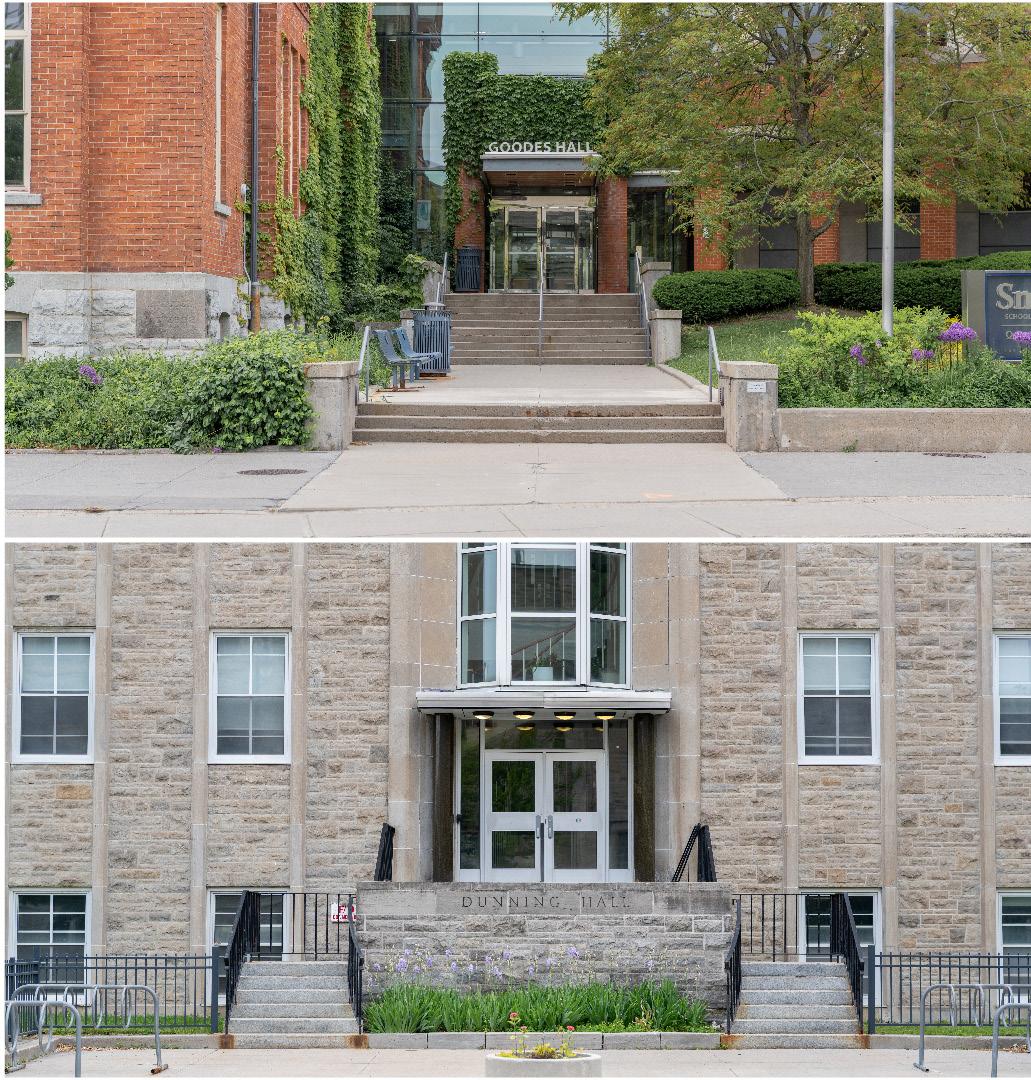
“We have a functioning body, so why not use that? Faculty members attend, they vote, they’re certainly capable of putting forward names and voting on these names to be on this search
committee,” Pappano said. In a statement to The Journal, the University touched on the fact that the changes to policy weren’t approved and explained they will follow the existing policy until it’s changed.
“Any changes to the policy must be initiated and supported by the Senate [...] In the meantime, the University remains obligated to follow the procedures outlined in the policy and is doing so in the searches for Smith School of Business and the FAS,” the University wrote.
Similarly, in a May 21 letter to Principal Deane, 50 professors at the Smith School of Business wrote to discuss faculty representation on their Dean search committee.
Continued online at www.queensjournal.ca
Senate calls for analysis on impacts of Arts seat reallocation
at the March Senate meeting, where Provost Matthew Evans explained that the programs recieving more students charge higher tuition than the BA, resulting in a projected $1.4 million increase in tuition revenue for 2026–27 and $2.9 million for 2027–28.
His first motion requested that, given the enrolment changes will lead to a roughly 20 per cent reduction of students in the BA and BA Honours student cohorts, Senate should be “presented with an analysis for discussion in Fall 2025 of the effects of the reallocation of student enrolments for 2026-27 and beyond.”
The motion was later amended to specify that the
Senate Committee on Academic Development and Procedures (SCADP)—which is responsible for formulating and recommending policy changes to the Senate—will be the group presented with an analysis. The motion was also amended for the discussion to take place in the 2025-26 school year rather than Fall 2025.
“Rather than wait to see what the effects will be of this four years from now, me and my colleagues, faculty Senators on Senate, thought, ‘Okay, let’s do some analysis up front, see what the effects might be, and then have a discussion at Senate’, which is the body charged with stewarding the academic mission, [discuss] what
these effects might be,” Cohen said in an interview with The Journal Cohen points out the possibility of programs being cut as a consequence of this motion. explaining how oftentimes when programs are being suspended and brought to the Senate for final approval, it’s at a time where nothing can be done to prevent it. However, he hopes this motion will be able to prevent this issue by outlining concerns in advance.
Continued online at www.queensjournal.ca
School of Business (top) and ArtSci (bottom). PHOTO BY JASHAN DUA
Queen’s paints new Pride crosswalks
University updates design from rainbow stripes to Progress Pride flag
Lilly Meechan Assistant News Editor
Queen’s is showing its pride this June through various initiatives, including two newly painted Pride crosswalks on campus.
To mark the beginning of Pride month, Queen’s has repainted two crosswalks in the Progress Pride Flag colours, differing from previous years using raindbow stripes. The installations are part of an annual visibility initiative that first began in 2022, and include raising the Progress Pride flag, the Positive Space campaign, and more.
One crosswalks has been installed at the intersection of Bader Lane and University Avenue,
Leading with Pride: Patrick Brant Kingston Pride Parade Marshal Pride in news
with the other near the south parking lot off Hargreaves Way on West Campus.
The new flag adds black, brown, light blue, pink, and white chevron shapes to represent racialized, transgender, non-binary people, and people who have been impacted by HIV/AIDS, within the 2SLGBTQIA+ community.
Beyond the crosswalks, Queen’s broader Pride Month efforts extend to the raising of the Progress Pride Flag outside the JDUC and student-led initiatives hosted by groups such as the Yellow House, including their sign-making event held at the beginning of June.
The installations were repainted for the beginning of June, in coordination with Physical Plant Services, which is the department responsible for the upkeep and maintenance of the universities grounds. The project is completed with paint designed to last throughout the summer.
In a Queen’s Gazette article, the University explained that the Progress Pride Flag was selected
for its broader representation of gender and racial diversity within the 2SLGBTQIA+ community, with Patrick Deane, principal and vice-chancellor, touching on its significance.
“The crosswalks, as well as the Progress Pride flag, indicate this is an inclusive place and that we value and support diversity in our community,” he said in the article.
The newly painted crosswalks are part of Queen’s larger goal to make inclusion visible yearround, something Tony Gkotsis, Queen’s Director of Campus Planning and Real Estate, stressed in the Queen’s Gazette article.
“Every opportunity we have to create a welcoming environment for all of our population; we need to take those opportunities,” Gkotsis said.
While no ceremony accompanied the repainting this year, the University has confirmed that the efforts for inclusivity and queer visibility, such as the crosswalk, will continue annually as part of its commitment to equity and inclusion.
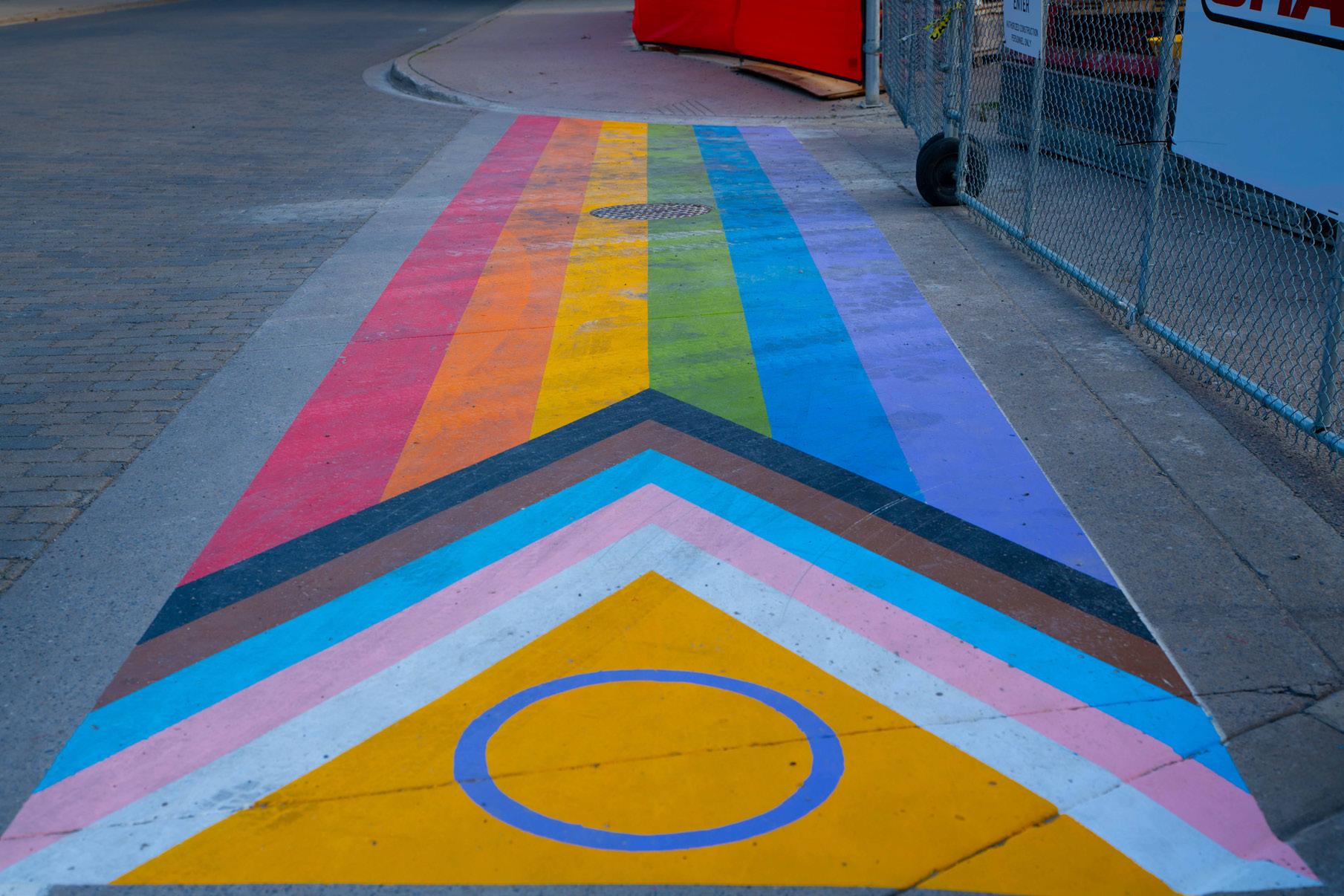
Protestors join parade in spreading awareness
Kaliyha
Dennis, Assistant News Editor
As rainbow flags fluttered down Princess St. and music filled the air, Kingston’s Pride Parade burst to life with celebration, colour, and a message from protestors.
Kingston Pride staged its annual parade starting at the Memorial Centre and winding toward Confederation Park on June 14. Thousands marched through downtown Kingston, showcasing solidarity across the 2SLGBTQIA+ community and its allies. As the month progressed, booths began popping up along the street, selling Pridethemed merchandise to locals preparing for Kingston’s biggest
Pride event of the year.
This year’s festival theme, “The Rainbow and Beyond: Stronger Together,” was selected by the Kingston Pride Board to represent the diversity and strength of the Kingston community, both within and beyond the 2SLGBTQIA+ spectrum.
At noon, the parade kicked off with Grand Marshal, Patrick Brant, an Indigenous Canadian drag queen, artist, and vocal activist for 2SLGBTQIA+ inclusivity, leading celebrations. Marching behind were local students, Kingston residents, and businesses—large and small—proudly showing their solidarity.
Among the crowd, there was a large representation of the University community, including AMS Commissioner of Social Issues (External), Edward Sy, Commissioner of Social Issues (Internal), Mujeedat Lekuti, and Keith McNinch, events coordinator for Queens and
‘I like to advocate for queer needs across our community’ says Two Spirit Kanien’kehá:ka
Daniel Gill-Sitoski
Assistant Arts & Culture Editor
Elected by his Kingstonian peers, Patrick Brant led the charge of this year’s pride parade. Brant took center stage as Marshal of this year’s Kingston Pride Parade, bringing his years of community activism to one of the city’s most visible and vibrant celebrations of 2SLGBTQIA+ pride. Selected ahead of the June 15 parade—the focal point of Pride Week—Brant led participants from the Kingston Memorial Centre through the downtown core, finishing in front of City Hall. Pride Week ran from June 8 to 15, featuring events across the city.
Identifying as a Two Spirit Kanien’kehá:ka activist, artist, and organizer, Brant’s story in Kingston includes partnerships with community organizations like the Kingston Native Center and Language Nest, Sisters of Providence Center for Justice, Peace, and Integrity of Creation, and Seniors for Climate Action Now.
The role of Parade Marshal is both ceremonial and active. “The parade marshal is an elected position usually acknowledged for their contributions to the community. They lead the parade, setting the pace of the parade, may walk with a contingent, and give a speech to the participants to set the tone or speak to the reasons why they were chosen,” Brant wrote in statement to The Journal, Now a familiar face in Kingston’s 2SLGBTQIA+ community, Brant helped launch one of the city’s most impactful drag events: Kingston’s inaugural Drag Queen Storytime. As both organizer and performer, he appeared as Fabula Queen of The North, reading the children’s book Tango Makes Three by Peter Parnell and Justin Richardson at the Skeleton Park Arts Festival in 2015. The event not only marks a first for Kingston but also contributed to the early rise of Drag Queen Storytime as a growing genre across North America.
Beyond pioneering the genre of Drag Queen Storytime, Brant has been active across several advocacy spaces in Kingston.
“I like to advocate for needs across our community including 2SLGBTQIA+ rights, Indigenous reconciliation, unhoused needs, environmentalism, healthcare, and mental health needs,” he wrote.
Brant brought his legacy of continued activism, community engagement, and positive spirit to this year’s Kingston Pride Parade as an embodiment of the tradition and joy embedded in the Parade Marshal’s role.
Kingston’s parade balances celebration with calls for justice
a prominent member of the 2SLGBTQIA+ community.
While the atmosphere was celebratory, the event also became a platform for broader political expression.
A quiet group of roughly 50 protestors moved through the crowd, holding signs that read “No Pride in Genocide.”
The protestors, including Queen’s students and Kingston locals, took part in the demonstration, carrying both Pride symbols and Palestinian flags and signs to shed light on what they viewed as an urgent but overlooked issue within mainstream Pride events.
In an interview with The Journal, protestor Camila Pinea emphasized that her participation went beyond celebrating
queer identity, aiming to raise awareness for global injustices.
Pinea highlighted the importance of advocating for those facing
oppression elsewhere, particularly in Palestine.
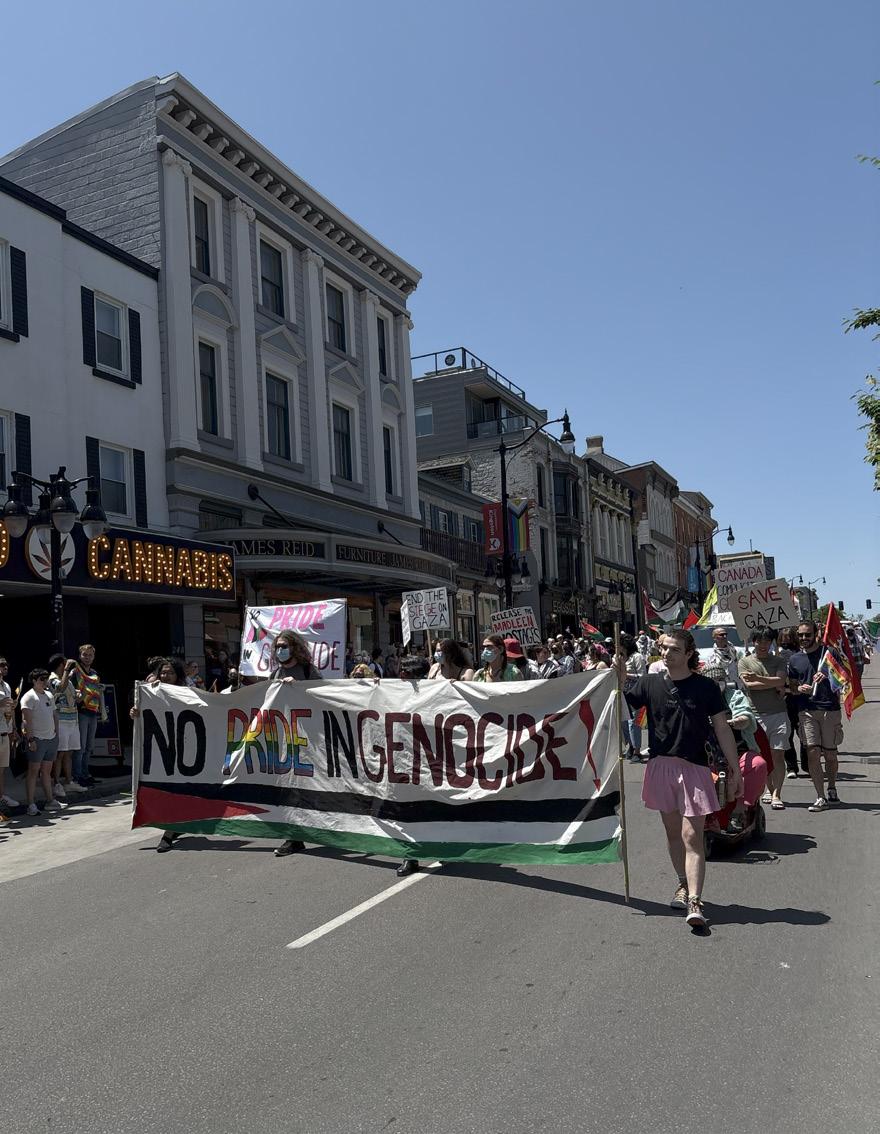
The protest ended on sidewalk outside of Mark Gerretsens’ office, the federal Member of Parliament for Kingston and the Islands. Demonstrators continued to call for global solidarity, urging that Pride not only be a celebration but also a space for justice, political expression, and intersectional resistance. After the parade, community members gathered in Confederation Park, where booths, performances, and activities continued the day’s events. Local organizations offered resources, information, and giveaways, providing a space for attendees to connect, learn, and celebrate together.
Progress Pride flag at Bader Lane.
PHOTO BY JASHAN DUA
Pride Parade Protest. PHOTO BY KALIYHA DENNIS
Bill 33 threatens student services and autonomy across Ontario universities
From clubs to admissions, new Ford Bill could upend how Queen’s operates
Lilly Meechan & Yael Rusonik
Assistant News Editors
New provincial legislation could lead to significant changes for student life in Ontario.
Bill 33—the Supporting Children and Students Act— proposes sweeping changes to how post-secondary institutions operate. Introduced on May 29 by Minister of Education, Paul Calandra, this legislation would allow the Lieutenant Governor in Council to regulate which student fees are mandatory at post-secondary institutions and implement new regulations surrounding admission processes.
In a press release on the Ontario Newsroom website, Calandra justifies the Bill as a way of “strengthening accountability and transparency,” and ensuring “every dollar invested is preparing students with practical skills for good-paying, stable careers.”
In an interview with The Journal, Vice-President (University Affairs), Alyssa Perisa, explained how Queen’s campus would be negatively affected if the Bill results in students being allowed to opt out of mandatory AMS fees.
New ORT Director named following resignation
Jonathan (Johnny) Shenouda returns as a director after years of work in ORT
Meghrig
Milkon Editor in Chief
Following an abrupt resignation just ahead of Orientation season, the AMS has appointed its second Orientation Roundtable (ORT) Director this year.
As the University and the AMS prepare for the arrival of the Class of 2029, the AMS ORT welcomes its new Director, Jonathan (Johnny) Shenouda, who brings previous experiences in orientation along with strong focus on equity, accessibility and student

“Without the AMS, you wouldn’t be able to run a club. There’d be no student-run events,” Perisa said. “The Campus Affairs Commission gave out $31,000 in grants and bursaries last year, and the Social Issues Commission will be giving out $35,000 in grants. That’s more than $60,000 given back to the students.”
The Commissioner of External Affairs, Edlira Ballaj, ArtSci ‘26, echoed the same concerns on how Bill 33 could impact on-campus services.
“Services like Walk-home, Peer Support Center, Food Bank, the Media Center, my commission as a whole, these services rely on AMS,” Ballaj said in an interview with The Journal. “So, when the AMS itself is at risk, all these other services will also be at risk and diminish.”
This isn’t the first time post-secondary institutions have been threatened, with Bill 33 mirroring the Student Choice Initiative of 2019, which allowed students to opt out of paying certain ancillary fees deemed “non-essential” by the provincial government, before ultimately being struck down in court that same year.
“In 2019, the Student Choice Initiative was actually enacted for that year, and we had to make our mandatory AMS membership fee optional,” Ballaj said. “That caused a lot of instability, at least within the organization.”
Beyond impacting student fees, the legislation includes a provision requiring universities to assess applicants based on
engagement—traits he believes make him well suited for the role.
Shenouda steps into the role after the recent resignation of Ali Haider, HealthSci ‘26, who announced on LinkedIn on June 8 that he would be starting his Doctor of Medicine at the University of Toronto’s Temerty Faculty of Medicine, signalling his resignation.
A recent graduate of Queen’s Bachelor of Health Sciences program and a soon-to-be dual certificate student in business and law, Shenouda, is no stranger to campus life—or orientation. His journey started during the pandemic with a hybrid orientation experience he describes as less than ideal. Determined to improve the student experience, he returned the following year as a head COAT and then systems
Club’s Commission sees a major shakeup
Restructuring and ratification overhaul to clubs coming this year
Yael Rusonik Assistant News Editor
Queen’s students can expect significant changes to the AMS Club’s Commission.
to make sure that students are feeling supported.”
The March proposal also called for a reallocation of responsibilities within the Club Commissions itself. The previous team of five employees is being replaced by three new positions—a Clubs and Policy Supervisor, Clubs Communications & Development Supervisor, and Clubs Operations & Finance Supervisor—all of whom report directly to the Club’s Commissioner.
publicly disclosed “merit” criteria. This means universities would be required to define and publicly share the specific qualifications or achievements they use to evaluate applicants. Then, the cabinet can make changes to the criteria as they see fit, potentially changing how admissions decisions are made.
In an interview with The Journal, Member of Provincial Parliament for Kingston and the Islands, Ted Hsu, expressed that the cabinet’s ability to influence those criteria could result in fundamental changes to how universities go about their acceptance process. While Hsu stopped short of accusing the Ford government of explicitly targeting DEI, he acknowledged that the concern is legitimate.
“The province, [Ontario], might want to ignore diversity, and the university might say no—that’s important for what it means to be a university and to expose people to different people who live in Ontario,” Hsu said.
Despite the uncertainty of Bill 33, Hsu encouraged students to stay engaged and recognize their role in shaping the future.
“If you’re worried about what the world looks like today, remember: you’re at one of the places where the world 50 years from now is being determined,” he said.
Bill 33 will be read a third time when the legislators’ summer recess is over, with the house not expected to return until mid-Oct.
and support director, helping shape the still-developing Health Sciences orientation.
“Orientation is the ability, first of all, to socialize,” Shenouda said in an interview with The Journal “It’s also the biggest chance we get to meet and learn about different perspectives from across the world, whether they be international students, across different faculties, there is so much we don’t know.”
“No orientation is perfect, and this is the chance that we probably get to integrate [The student body with the AMS]. So why am I coming back to ORT, one for my personal growth, and two, to continue building those strong relationships with people and understanding the communities that we’re [AMS] serving,” Shenouda added.
While Shenouda stepped into
AMS-ratified clubs will now apply for re-ratification on a bi-annual basis, instead of annually, to better suit the capacity of the Clubs Commission, according to Xian Tronsgard AMS club’s commissioner, in an interview with The Journal. This change comes after the AMS Assembly last March approved a proposal to the AMS Board of Directors outlining several changes to the Clubs Commission.
Changes include that all clubs ratified during the 2024-25 school year will be automatically re-ratified for the 2025-26 school year. In addition, clubs will be randomly split into two cohorts that will apply for re-ratification on alternating years. This year, all clubs will hear which cohort they’re in by the end of July.
“The AMS has over 350 clubs, so the operational capacity is quite different in comparison to other schools,” Tronsgard said. “The capacity of the Clubs Commission can’t successfully and equitably re-ratify all those clubs within a one-month time frame. So that’s why we’re deciding to split them up.”
While Tronsgard acknowledges the risks associated with less frequent ratification, she believes that through implementing new internal mechanisms, such as financial audits, and encouraging better communication and collaboration, this will be a positive change.
“This will be the first year, and we don’t expect it to be perfect,” Tronsgard said. “But I think the greatest thing about the club’s commission is that we’re very adaptive, and we’re very receptive to student feedback. We want
Tronsgard explained that the Clubs and Policy supervisor will be tasked with “policy compliance and researching” and making policy “more accessible.” The Clubs Communication and Development Supervisor will help with “making centralized documents” and “making resources available to clubs,” and the Clubs Operations and Finance Supervisor will “assist the clubs for any administrative inquiries.”
All three positions are hiring until July 6.
In addition to the proposals already outlined in March, Tronsgard is focused on implementing further changes to “clarify definitions” and ensure “transparency in [the Commission’s] procedures.” This includes a redesign of the commission’s website, and the implementation of a new Help Desk ticketing system, designed to help club executives better track their tickets and reduce response times from twelve business days to five.
After last year’s Clubs Commission Restructuring Proposal found there was an overall sentiment of AMS clubs feeling unsupported, Tronsgard is committed to creating a better relationship between clubs and the Club’s Commission.
“The AMS has done an amazing job of being receptive to the feedback,” she said. “To be able to be the first [AMS] Club’s Commissioner that has the help desk, a brand-new club directory, centralized documents—I think it’ll be a great step in the right direction [for] the relationship between the clubs and the Commission.”
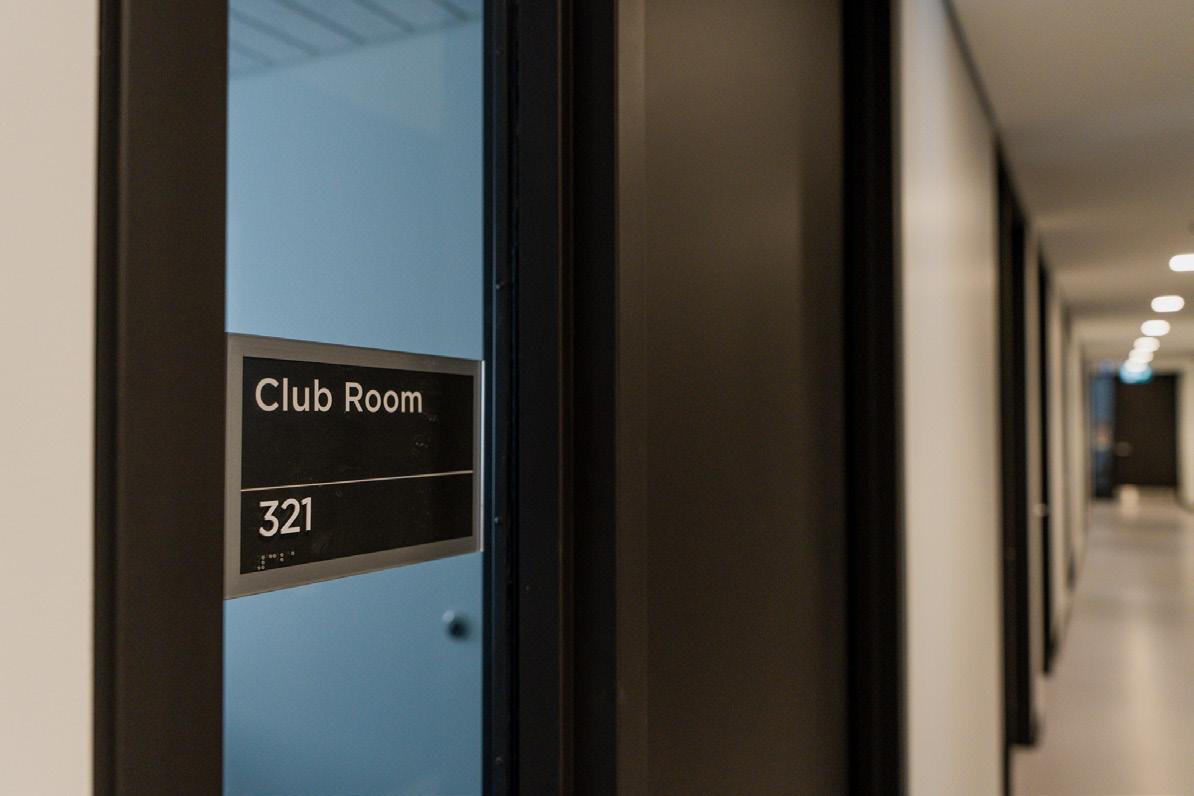
the coordinator role mid-cycle, he emphasized the importance of institutional knowledge, communication, and trust within the orientation team. Working alongside Haider during the transition has strengthened the team, Shenouda says, as
faculty members now have two directors supporting them through orientation instead of one.
Restructuring overhaul to clubs coming this year. PHOTO BY JASHAN DAU
The Bill was introduced on May 29. GRAPHIC BY ARDEN MASON-OURIQUE
National Indigenous
day
fills park with art, music, and storytelling
Kingston gathers to celebrate Indigenous culture
non-Indigenous attendees to engage with art, ceremony, food, and learning.
Kaliyha Dennis Assistant News Editor
The Kingston community gathered at Confederation Park to mark a day of celebration of Indigenous Pride.
National Indigenous Peoples Day, held annually on June 21, is a nationwide celebration recognizing the history, heritage, and diversity of First Nations, Inuit, and Métis peoples across Canada. In Kingston, community members gathered at Confederation Park for an afternoon of performances, teachings, and cultural activities organized to honour Indigenous traditions and create space for reflection and celebration.
The event was hosted by Kingston Native Centre and Language Nest offering opportunities for Indigenous and
The opening ceremony began at 1 p.m. on the main stage, featuring music, storytelling, and dancing. Surrounding the stage, a wide variety of food and market vendors offered Indigenous-made goods, including beaded earrings, orange shirts, dreamcatchers, and more.
In an interview with The Journal, one of the vendors from Yellowknife shared, “coming to this event is always nice, we get to sell and share our beautiful art with the community, art that people often don’t have access to during the rest of the year.”
The celebration also welcomed special guest Billie Kearns, Sci’19, also known as Billie the Kid, originally from Yellowknife, Northwest Territories. During the ceremony, she performed a spoken word piece reflecting on her journey from Yellowknife

High school student awarded $120,000 STEM scholarship
Whether he’s building robots or tutoring his classmates, Aden Blanchette is ready to dive into life at Queen’s
Yael
Rusonik Assistant News Editor
From Northern Ontario, Aden Blanchette is heading south with a $120,000 scholarship in hand.
Blanchette, a high school senior from Timmins, a city in Northern Ontario, has been awarded one of Canada’s prestigious STEM scholarships—the Schulich Leader Scholarship—to support his upcoming studies at the University. The scholarship is valued at $120,000 and is awarded to 100 STEM students annually through 20 partner universities. The recipients are chosen from a group of over 300,000 candidates, and 1500 nominees.
In an interview with The Journal, Blanchette expressed his excitement about coming to Kingston and starting the next chapter of his academic journey. He will be joining the Smith Faculty of Engineering in the Mechatronics and Robotics stream—a direct entry program that combines

mechanical, electrical and computer engineering with elements of robotics, automation and programming.
“A lot of [my teachers] have attended Queen’s,” he said.
“They’ve told me a bunch of good
things [about Queen’s]. The community there is fun, and the classes are also. They liked their experience [there].”
This past year, Blanchette channelled his passion for STEM into building a robotic arm and a
to Kingston, highlighting her transition to a less diverse institution, her experiences and retaining her cultural identity while living in Kingston.
The event included activities for all ages, such as a kids’ zone featuring an inflatable corn maze, a mural, red dress art installation, and teachings on the Four Sacred Medicines: tobacco, sage, cedar, and sweet grass. These medicines hold deep cultural and spiritual significance
3D-printed game for his English class. While he doesn’t have any specific projects in mind, Blanchette is looking forward to continuing to brainstorm and work on different projects at the University.
“I find it super cool being able to put numbers in ways that let you discover new things. I’ve always just had this interest in STEM,” he said. “And then [my physics teacher] mentioned his daughter who is studying Mechatronics Engineering [at Queen’s], and the way he described it made it sound like it was exactly what I wanted to do in my future.”
As a Schulich Leader, Blanchette is committed to not only leaving
in many Indigenous communities and are often used in ceremonies for healing, protection, and connection.
Free of charge, the event welcomed many curious community members strolling through the downtown Kingston market, who were able to end their day at the celebration, grabbinga bite to eat and listening to stories on stage.
his mark on the University’s STEM programming but also making a positive impact on the community at large.
“One of the ways I really enjoyed helping my community is by being a person that anyone could come up to,” he said. “I was a tutor, and I still help my friends in their classes. I hope I’m still able to do that at Queen’s. I hope I understand my material well enough for that.”
By the end of his undergraduate experience, Blanchette hopes he will be able to look back and be proud of the friends and decisions he’s made and feel accomplished.”
“Oh, and build a bunch of little robots,” he added. “That would also be cool.”
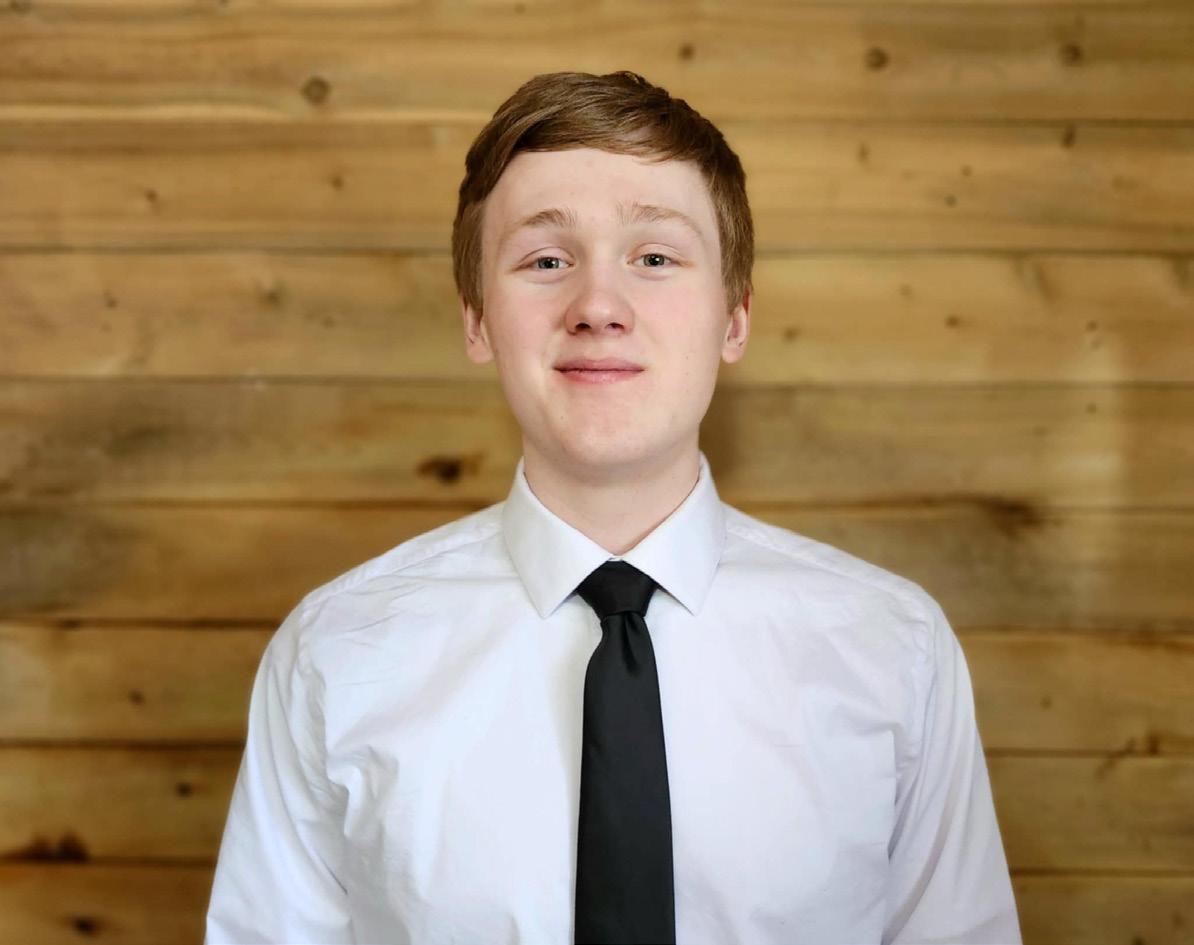
National Indigenous Peoples Day Celebration at Confederation Park on June 21 PHOTO BY KALIYHA DENNIS
Blanchette holding contraption.
PHOTO SUPPLIED BY ADEN BLANCHETTE
Blanchette headshot. PHOTO SUPPLIED BY ADEN BLANCHETTE
FEATURES
Queer religious students grapple
with seemingly conflicting identities
‘I wish I still felt welcome in church’ student says
Aaniqa Karmali
QTBIPOC Advisory Board Member
For many queer religious students at Queen’s, navigating faith and identity means confronting tensions that often feel at odds—especially in 2025, as conversations around inclusion and representation continue to evolve both on campus and in faith communities.
One student who knows this struggle firsthand is Marcus Stokes-Rees, ConEd’28, who grew up in a Christian family. Today, Stokes-Rees remains a practicing Christian, but his journey as a queer, religious person hasn’t been without obstacles.
Stokes-Rees realized he was queer at a Bible study Christian camp he attended every year from grades four to 12. One day at camp when he was in grade four, campers were instructed to write letters to God and then burn them. The letters could contain anything—a confession, prayer, or diary entry. For Stokes-Rees, who had never admitted out loud that he was queer, this was the perfect opportunity to let out this long-held secret. Stokes-Rees decided not to burn his letter.
“I wrote about how I felt in my gender and my sexuality, and we were supposed to then burn these letters, but I ended up keeping mine,” Stokes-Rees said in an interview with The Journal. “I kept it as a little reminder that God was going to know what I felt, regardless of whether or not I wrote a letter about it.”
Having finally come to terms with his queerness, Stokes-Rees sought out a queer community at camp. Though still in the closet, he met other queer Christian campers and started to feel comfortable in his own skin. However, he soon realized that his church—and the camp that defined his adolescence—condemned his very existence.
“The main reason I don’t go to church is because many of the people that go to the church also went to this camp,” Stokes-Rees said. “The camp that I went to had a very, very strict doctrine in terms of what we were allowed to talk about and how we were allowed to
became the target of homophobia from the camp administration. His superiors noticed he was spending a lot of time with his male cousin and, because they didn’t share a last name, wrongfully assumed there was “something homosexual” about their friendship, Stokes-Rees said. They were told they were giving campers “the wrong idea” and were instructed to stay apart.
and queerness. However, losing his community has been an isolating experience.
“I wish I still felt a place in church, and I wish I still felt a place honestly back at this camp,” Stokes-Rees said. “I really hope that in the future they can maybe realize some of their practices weren’t very beneficial to most of the kids’ takeaways,” Stokes-Rees said.
“My religion would tell me that I’d have to feel like these people are sinning and to try to convert them, but how I actually felt was I don’t care what they’re doing, and I just want to be happy for them,” she said.
talk about that .”
He learned as a child attending camp that certain topics simply weren’t discussed, but becominga counselor in grade 12 revealed the true extent of this censorship. Stokes-Rees was instructed not to talk to campers about ‘taboo’ topics like gender expression, divorce, and doubts about religion. He and other counselors were also required to sign a contract stating that they would not talk to campers about being queer and Christian.
“It was really discouraging to see the way that they minimized any conversation sabout[controversial] issues and children’s questions about religion and how that has to do with queerness,” Stokes-Rees said.
As a counselor, he also learned that many parents sent their children to this camp to quell any desire to explore their gender identity
Stokes-Rees reached a breaking point when he saw this happen to several other campers. Campers who bonded because of shared experiences and struggles were separated for getting too close—sometimes even moved to different cabins. They were forbidden from fostering genuine connections and support systems because doing so could, once again, give their peers the wrong idea.
“I didn’t like the fact that I wasn’t able to support [these campers] or be able to show any type of representation within the camp because I wasn’t allowed to talk about [queerness],” Stokes-Rees said. “I wasn’t allowed to acknowledge anything or show that people could still be Christian and be queer.”
Ostracized by members of his church, he realized his church stigmatized queerness the same way this camp did . He couldn’t speak a word about his queerness, let alone embrace his identity. Stokes-Rees, who grew up
Sasha* felt pressured to choose between her faith and queer identity from internal and external pressures. Growing up, being a Christian was a core aspect of Sasha’s life and identity. She attended a Fundamentalist private school for ten years and was actively involved with Christian youth groups. Never missing a Sunday at church, Sasha’s faith forged her community—raised by devout Christian parents, religion was woven into all facets of Sasha’s upbringing.
Like many adolescents in high school , Sasha had questions about her sexuality and orientation. But the concept of queerness felt both foreign and shameful. In her core community, the youth groups she attended throughout high school, any questions about being gay were answered with advice on how to stop those thoughts through prayer and discipline.
“I don’t think I met a queer person until I was
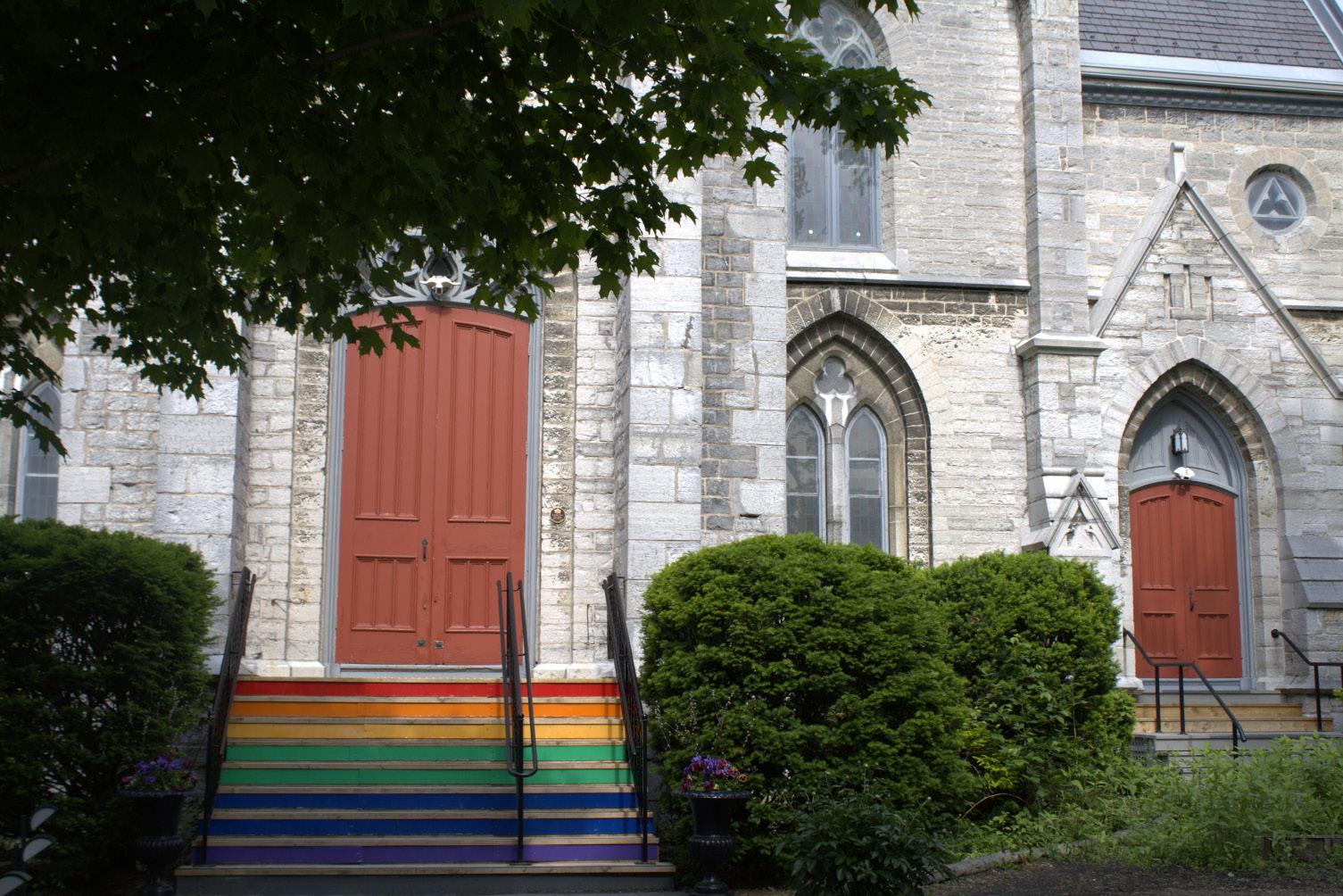
or sexual orientation.
“Part of the reason why parents would send their kids to this camp was because they weren’t necessarily acting feminine or masculine enough,” Stokes-Rees said. “It was really skirted around that that was the real reason parents were sending their kids there, thinking that having an immersive experience where you’re constantly talking about the Bible and having Bible study would be the most ‘effective.’”
In his last year at the camp, Stokes-Rees himself
with communal prayer as his main expression of faith, turned to the Bible for solace and comfort.
“I spent a lot of time looking at the Bible and really just the teachings of Jesus, mostly, and I realized that above all, what [the church] taught that they didn’t really focus on was the fact that you’re supposed to accept everyone,” Stokes-Rees said.
Focusing on this aspect of Christianity rather than his church’s views of his queer identity helped Stokes-Rees remain committed to faith, without forcing him to choose between religion
Around the same time, Sasha realized that she was attracted to women. But, after being told repeatedly by those closest to her that being queer was unacceptable, she abandoned any hope of living—and loving—authentically.
“I treated [my sexuality] as a shameful thing that I was never going to actually explore and that I’d find a way to get over, so I just completely compartmentalized it,” Sasha said. “I didn’t fully accept it until second- or third-year of university, and in order for me to do that, I had to lose my faith.”
During her time as an undergrad, Sasha realized her parents’ religion was incompatible with her core values. Her church’s view of queerness was certainly a point of contention, but she also disagreed with fundamental aspects of Christianity, including the concepts of sin and hell. Now identifying as an atheist-agnostic, Sasha feels her Christian upbringing impacts her identity to this day.
“I struggled for a long time feeling really guilty over insignificant things because I was raised in the mindset of [believing] everything you do wrong is a sin,” Sasha said. “It just makes it seem so big and important and kind of tied to who you are instead of recognizing you’re just a human that made a mistake.”
“I have a lot to unpack, which I have been doing in therapy, but I don’t identify as a Christian anymore,” Sasha said. ***
For those raised religious, like Omar Bui, CompSci ’27, certain teachings of faith remain relevant to queer identity. Bui was raised in an Arab, Muslim family. Despite no longer being a practicing Muslim, their upbringing has had a major influence on how they view community in queer spaces today.
fourteen or fifteen,” Sasha said in an interview with The Journal. “To my knowledge, there weren’t any [queer people] at my school, and any mention of gay people had an undertone of, ‘this is a sin, this isn’t something that God would want.’”
After transitioning to the public school system in high school, Sasha gained more exposure to queer people. She met several gay peers—sparking an internal conflict between her church’s view of the 2SLGBTQIA+ community and her own.
Growing up Arab and Muslim in a Western country presented a unique set of obstacles, according to Bui. Many Muslim immigrants faced discrimination due to Islamophobia and xenophobia; others were forced to rebuild their lives in Canada after fleeing conflict in their home countries.
Continued online at www.queensjournal.ca
Queer, religious students discuss navigating the intersection of faith and queer identity.
PHOTO BY SARAH ADAMS
Queerness isn’t an option—and neither is its place in the curriculum
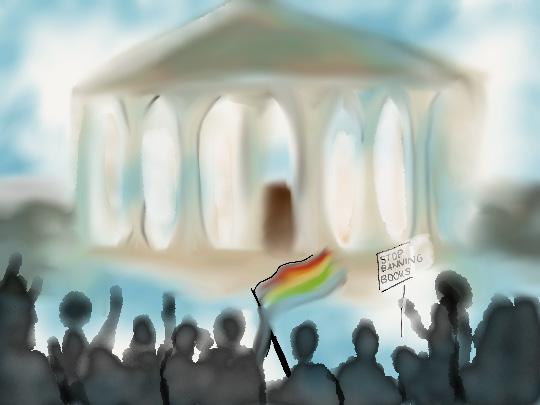
What children learn in schools shouldn’t be limited to their parents’ perspectives.
This Friday, the Supreme Court ruled in favour of Catholic, Muslim, and Ukrainian Orthodox parents in Maryland who want to opt their children out of reading 2SLGBTQIA+ books in school—demonstrating an unfair mitigation of representation and highlighting the critical role of education in exposing children to a variety of beliefs and world views.
The purpose of the public school system should be to represent all perspectives and ways of life. Representation of 2SLGBTQIA+ themes in the curriculum is an important method of combating the taboo around sexuality in school. Exposure to new ideas is a vital part of teaching children the concepts and views that reflect an entire society.
It’s important to note that secularism
Trump’s assault on migrant rights risks the death of due process
The Trump administration’s latest attack on migrant rights by the considering suspending habeas corpus is both cruel and constitutionally unprecedented.
As of early May, the Trump administration announced that they are “actively looking at” suspending habeas corpus—the right to a fair trial— for detained migrants. The White House’s Deputy and Chief of Staff, Stephen Miller, repeatedly used the justification that the United States is facing an invasion by immigrants.
According to The New York Times, Habeas corpus has only been suspended four times in the United States’ history, most recently following the attack on Pearl Harbour in ’41. The contrast in events warranting the use of the suspension illustrates the current US administration’s exaggeration of the ‘immigrant threat’, one with potentially harmful consequences.
Evident from the slew of executive orders placed during the first 100 days of his presidency, Donald Trump has no interest in abiding by the Constitution. What’s most surprising is the public’s confusion over Trump simply following through on his campaign promises. This most recent attempt at suspending another fundamental right shouldn’t come as a surprise to those who
within education is a primarily Western value. It’s unfair to expect immigrant children, for example, to abandon their religious teachings when they step into the classroom. But this doesn’t mean that one perspective or way of life should be removed from the curriculum. Rather, all ideologies should be reflected.
The erasure of 2SLGBTQIA+ themes in literature accessible at schools has the potential for seriously negative consequences.
One particular consequence at the forth mind is the impact on family dynamics, where queer children growing up in religious families that are opposed to 2SLGBTQIA+ education and lack academic representation may feel isolated, ultimately fostering division from their family and limit their sense of belonging.
The intersection of religion and queerness is vast and complex, but it doesn’t mean the two cannot coexist. Opting out of 2SLGBTQIA+representation in schools for religious reasons pushes a single interpretation of religion, which may not be true for everyone within a society. This complexity highlights the necessity of an objective curriculum.
Continued online at www.queensjournal.ca

voted for a platform rooted in discrimination and fundamentalism.
Aside from his blatant disregard for the judicial branch, Trump’s violations reflect a deeper moral failing that goes beyond Constitutional violations. Every person— regardless of citizenship status—deserves the right to a fair trial. Asylum laws exist to help all people—regardless of citizenship—to escape genocide and prosecution, a principle enshrined in the Refugee Act of 1980. Yet, these fundamental protections have been repeatedly violated by the current president.
Concerningly, attempting to suspend habeas corpus is only a drop in the bucket of what the Trump administration is capable of. Trump has been known to weaponize the interests of his party to sustain executive power, starting with his executive orders, and moving into a systemic removal of checks and balances, including removing independent agencies and granting himself spending authority. These unprecedented actions will undoubtedly have lasting effects on the legitimacy of the United States government.
Framing immigration as an invasion, rather than seeking asylum, is a racially charged argument and deeply harms the immigrant community.
Continued online at www.queensjournal.ca
DocumenteD or not you’re at risk
Meghrig Milkon Editor in Chief
The United States Immigration and Customs Enforcement (ICE) isn’t protecting anyone—it’s terrorizing communities, and it’s time it gets abolished.
Since the start of his presidency—and even during his campaign—Donald Trump promised mass deportations, targeting more than 10 million undocumented immigrants living in the United States. His administration has followed through with 11,000 people deported in February, over 12,000 in the first four weeks of March, and approximately 17,200 in April, according to NBC News.
According to its website, ICE was established in 2003 through the merger of the investigative and interior enforcement functions of the former U.S. Customs Service and the Immigration and Naturalization Service. ICE currently operates in 400 offices across the United States and internationally, with an annual budget of approximately eight billion dollars.
Nearly 60,000 migrants are currently being held in ICE detention centers, with 11.4 per cent fast-tracked for deportation, according to NBC’s live tracker.
What the live media coverage makes evident is that the administration continues to view immigrants and migrants as statistics rather than people: a true testament to the tragedy that is the United States.
Stephen Miller, White House deputy chief of staff, stated that ICE officers would aim to carry out at least 3,000 arrests per day, an increase from the approximately 650 daily arrests during the first five months of Trump’s second term. ICE operations have triggered protests across the U.S., often resulting in arrests and the imposition of curfews.
Just days ago, it was reported that Canadian citizen Johnny Noviello died while in ICE custody. According to The Globe and Mail, the cause of death remains under investigation. ICE stated that Noviello was being detained pending deportation proceedings, despite having entered the United States legally and becoming a lawful permanent resident in 1991.
In October 2023, Noviello was convicted in eastern Florida on charges of racketeering and drug trafficking and was sentenced to 12 months in prison. In May, he was arrested by ICE at a probation office and charged before the Trump administration for violating U.S. drug laws.
Unfortunately, Noviello isn’t the first and likely won’t be the last person lost to ICE’s inhumane treatment of detainees. CTV News reports that there are currently 55 Canadian citizens being held by ICE.
What’s more, a 2024 report has documented inhumane conditions within ICE detention centers. It found that 60 per cent of people in ICE custody are held under “mandatory detention,” meaning they’re denied the right to a bond hearing—a basic aspect of due process. Since March 2023, there has also been a 50 per cent increase in ICE’s use of solitary confinement, often targeting individuals deemed “at risk,” members of “vulnerable and special populations.
It doesn’t matter if you’re a citizen, a permanent resident—if you have ever been labelled an immigrant— under these systems, your rights can and will be denied.
Continued online at www.queensjournal.ca
ILLUSTRATION BY MIKAYLA QUIGLEY
ILLUSTRATION BY MIKAYLA QUIGLEY
OPINIONS
Society’s forgetting bisexual people
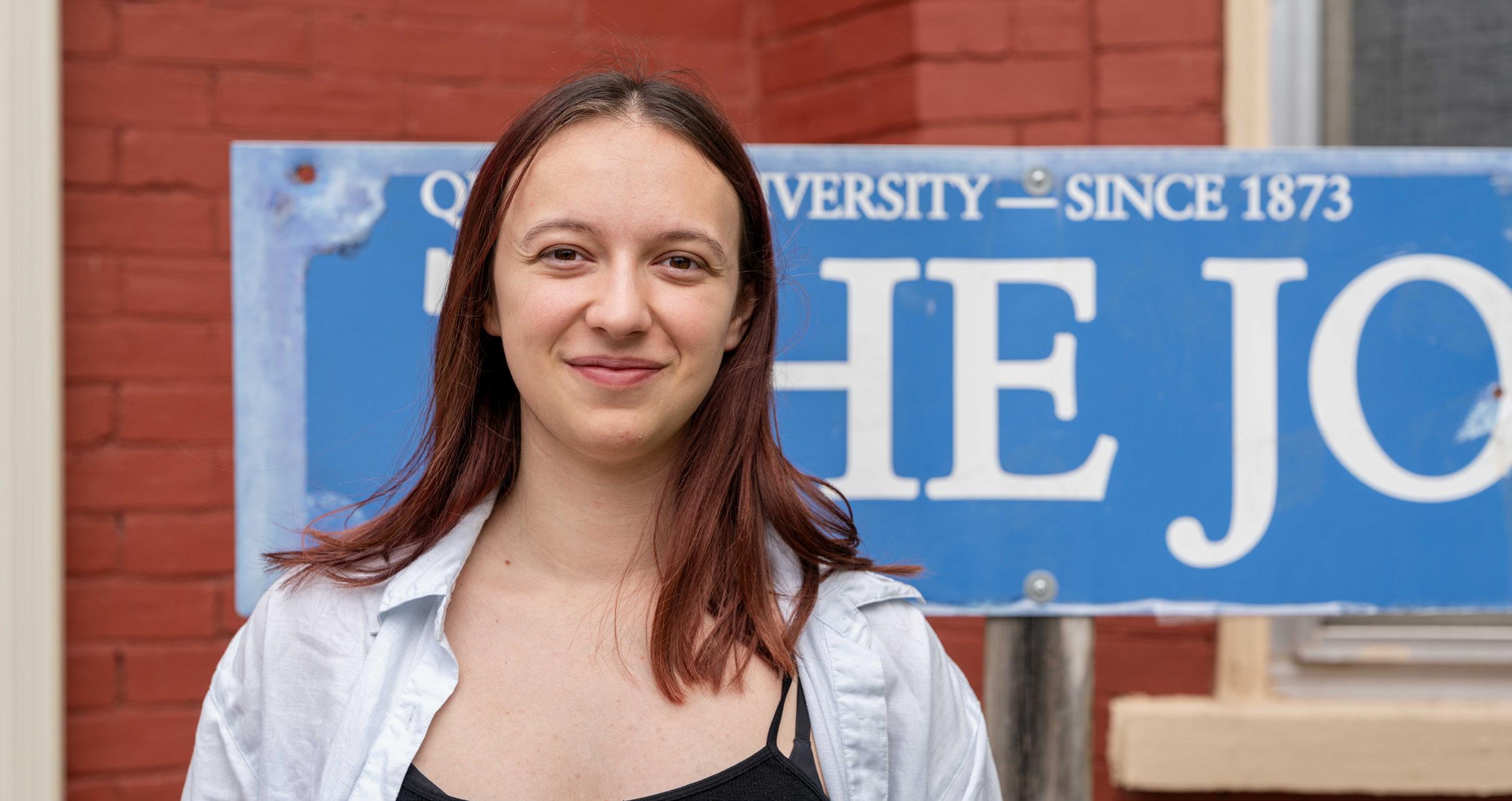
It only took me 20 years to come to terms with my bisexuality
Ella Marrie Campeau Contributor
Contrary to popular belief, bisexual people don’t centre men in their sexuality. I’ve been questioning my sexuality since I was 12 years old. The closet wasn’t something I felt I was ever in because I was always vocal to my friends and family about what I was feeling. For years, from ages 14-18, there was a running joke with my friends that I was going to “experiment” in university. Despite my biannual dream where I was in love with a woman, despite the way my eyes were drawn to the women, despite millions of other signs that I would eventually go on to make a powerpoint about, I still didn’t come to terms with being bisexual until I was 20. There’s a cliche that bisexual people often selfidentify as straight because they don’t feel queer enough. The problem with this line of thinking is that it operates within a cisgender/heterosexual framework that demands a binary presentation of your sexuality. I operated in this framework for a long time–scared to claim space that wasn’t mine because I hadn’t had a queer crush. To my credit, I crush extremely rarely and so not having a queer crush by the age of 18 was not weird–by that point I’d only ever had three crushes. Last year, after years of kissing women and still saying I was straight, I was watching a show and saw a masc lesbian who I
couldn’t stop watching thirst edits of when I had to face it: straight women don’t obsess over lesbian thirst traps! So, I’d come to accept my queerness, but that wasn’t enough to deconstruct the harmful binaries that we are all passed down through society.I’d been neck-deep in queer history, and discourse online since I’ve had social media so I thought by virtue of acknowledging my queerness I’d done the hard part. What I didn’t realise before is that as much as you can engage with queer theory and history from the outside, unless you’re intentionally deconstructing the cisgender/heterosexual framework we all live under, it doesn’t really hit you until you fully accept your queerness.
I’ve been thinking a lot recently about who I am, how I want to present, and what I actually want in romantic relationships. I don’t have an answer for any of these questions, but what I do know is that even when I still identified as straight, I never operated in a way that adhered to a traditional cis/het script. I’ve always asked out the people I liked despite being told by family members that that was unattractive and that as a woman, I needed to let people come to me. I have grown out my body hair since I was 15 and, even though many people in my life frequently tell me of how ugly and undesirable they think this makes me, I’ve had relationships and I’ve had people be attracted to me. More importantly, I’m comfortable in my body, and I feel confident and desirable.So much of the rhetoric I’d been told was centering the opinion of some theoretical straight man who I was supposed
to be appealing to. Bisexuality is societally thought of as a sexuality that centers men. Bi men are secretly gay, bi women are straight but attention seeking. Bisexuality is squished into a monosexual way of thinking that leads bisexuals to not want to critically engage with themselves or others because of these rigid binaries. For the record, I’m mainly discussing heterosexual ideas of bisexuality because I have found the queer community to be almost entirely accepting of bisexuality. In fact, surveys seem to show that roughly half of queer people identify as multisexual in some way or another. The beauty of bisexuality is in its fluidity. There’s a quote I love from Stone Butch Blues by Leslie Feinberg that encapsulates bisexuality to me: “But what gets it for me is high femme. It’s funny–it doesn’t matter whether it’s women or men–it’s always high femme that pulls me by the waist and makes me sweat.” By definition there are no rules with bisexuality, it’s yours to live and define. I hate to be cheesy, but bisexuality is entirely a queer identity–it’s not half of one thing or another. The problem a lot of people have with bisexuality is that they assume that we, like many non-bisexuals, center men and that any queer relationship or desire we express isn’t genuine. My response to that is that no matter your sexuality you can still center men and a cisgender/heterosexual framework. To assume that because bisexual people do date and love men they’re automatically unable to engage with queerness to the fullest extent is biphobic. As a chronically online person, I often find myself drowning in bisexual discourse
RectoR’s Digest: the gooD kinD of climate change
One
shift at a time
Niki Boytchuk-Hale
Staff Writer
The Principal’s 2020 Declaration of Commitment to Address Systemic Racism included a pledge to “eliminate gaps in support and resources for 2SLGBTQ+ students, staff and faculty,” and thus, one of those impressively long committee names was born—The Principal’s Action Group for Gender and Sexual Diversity (PAGGAS).
that serves no one.
One minute I’m watching a tiktok of people saying they’d never date bisexuals because they’re evil and all cheaters, the next I’m watching bisexuals who are sensitised to this endless discourse argue that everyone is being biphobic–even when they aren’t. It’s a never-ending cycle of feeling not enough while also feeling you’re taking up too much space.
The part that traps you in is that unless you log off and actually meet people in the queer community, you might not realise that the vast majority of people don’t think like that in-person. Still, bisexual people are often systemically an afterthought.
We can see the ways in which bisexuals aren’t considered in the same way monosexuals are.
Bisexualwomen have higher rates of being victims of intimate partner violence than both straight and lesbian women. Bisexuals can’t be lumped in with straight or lesbian women in these cases–being bisexual is a unique risk factor compared to other sexualities.
In the 80s, bisexual men were seen as sexually promiscuous superspreaders of AIDS–having sex with gay men and then spreading it to women. This information isn’t meant to make a case for comparing bisexual oppression against gay or lesbian oppression. It’s meant to outline the ways in which bisexuals occupy different spaces than both straight and gay people and thus need to be accounted for in social programs, studies, and policies. I want to end on a positive note. Queerness in all its forms is beautiful and liberating. I love being bisexual, I love the queer community, I love the ways in which it pushes me to be myself. In the words of Nick Nelson from Heartstopper “I’m bi, actually”.
A quick disclaimer: I anticipate I’ll be saying “last year I wrote...” quite often now. Unlike most student leadership roles, the Rector term can stretch up to 3 years, which means I get the privilege of showing up again, with some more experience and therefore hopefully a deeper insight. So, last Pride month, I painted a broad stroke picture of navigating activism at Queen’s. I’d like you to zoom in with me and take a finer look at one example of action: PAGGAS. PAGGAS is now embedded in the Vice Principal (Culture, Equity, Inclusion) portfolio and does what many of us do at Queen’s; tries to make sense of institutional spaghetti. Who owns what? Who can change it? Where can we push, or pull, or gently unthread a system so something better can grow? One example of this is their work understanding washrooms and changing rooms on campus—seemingly mundane, deeply meaningful. PAGGAS made recommendations to ensure everyone can feel dignified on campus with affirming and accessible spaces for all identities. Now, they are checking in with the process on the ground and providing further support. There’s no way even the most wellrounded committee composition could ever fully show up and rely on their own experiences. PAGGAS is made up of committee members from across the university, and some interact with students daily. The Yellow House and SHIFT Project staff are perfectly positioned to hear you out and inform the committee of your story. Systemic change is a long and drawn-out process with many bureaucratic hoops. To quote my mother from one of her pep talks, “You might not be the person to make it over the finish line, but you are starting it.” A perfect example of this is the then-student government leaders who proposed a studentled spinoff—SAGGAS—to bring more student voices and 2SLGBTQ+ representation. They graduated before much of this work was realized, but our community is better for it now.
At your service, Niki
PHOTO BY JASHAN DUA
Bisexuality needs to be seen as its own statistical demographic.
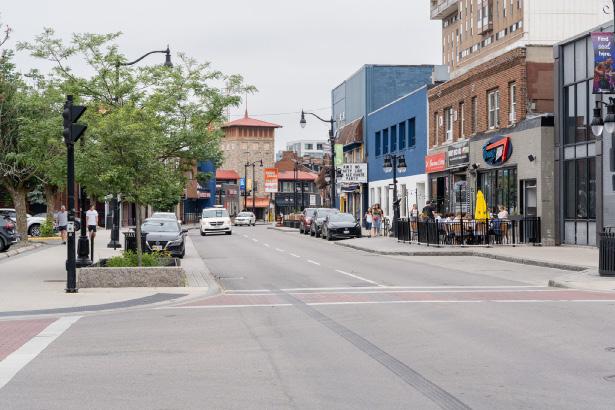
reflects practices that have long been part of how they operate.
Inclusion at work: Kingston businesses reflect on Rainbow Registered status
Local business owners say inclusive practices were in place long before formal recognition
explained, is built on respect and inclusivity.
Although the Rainbow Registered designation helps make those values visible to the public, Yanovsky said the principles have always guided how the business operates.
Local businesses are stepping up for inclusion.
In downtown Kingston, small, local businesses like Chez Piggy, Pan Chancho Bakery & Café, and Cher-Mère Spa are among the 15 in Kingston recognized among Canada’s Rainbow Registered program—a national certification that recognizes businesses committed to 2SLGBTQIA+ inclusion. For local owners, the recognition
“I was 11 when Chez Piggy opened,” Zoe Yanovsky, who’s been running both Chez Piggy and Pan Chancho since 2002, said in an interview with The Journal. “I was the dishwasher on opening day. When you’re part of a small family business, it’s part of your whole consciousness. It’s all-encompassing; it’s the dinner table, and it’s where you do your homework. I try to run the business within the sort of philosophy I grew up on.”
That philosophy, she
“Chez Piggy has been a respectful and loving place in every sense of the word,” she said. “Getting accredited didn’t change how we run. Being a place that’s inclusive and safe—and where our customers and staff are treated well—came long before the Rainbow Registry.”
Aba Mortley, owner of Cher-Mère Spa, shared a similar perspective. Her business, which uses natural products developed by her biochemist mother in Trinidad and Tobago, joined the Rainbow Registered program after years of creating an inclusive environment.
“As a Black person in Kingston, it was really important for me to make safe spaces,” Mortley said in an interview with The Journal. “The registry helps show people that we’ve been vetted, but we were already doing the work.”
Both Yanovsky and Mortley noted that in cities like Kingston—where small business owners often work closely with customers—local businesses can play an important role in building inclusive communities.
“If you’re trying to get commerce within a community, you should also be integral in trying to sustain and boost that community,” Mortley said. “Every month, we give back to a different community group in Kingston—not just to say it with words, but to follow through with actions.”
“When you go to the bakery [Pan Chancho], you’ll probably see me there. When you go to Cher-Mère Spa, you’ll probably see Aba,” Yanovsky added. “Small businesses play a huge role because we are part of the community. It’s an honour and a privilege and something we work hard at.”
Among the 15 Rainbow Registered businesses in Kingston, including Glow Skincare and The Smith Hotel, owners like Yanovsky and Mortley say the designation reflects practices that have been in place for years. For these businesses, inclusion is a routine part of how they operate and engage with the community that they’re a part of.
Meet Queen’s first-ever AI Advisor
Eleftherios Soleas speaks to what the future of AI will look like at Queen’s
As Artificial Intelligence (AI) tools take over university classrooms and offices, Queen’s has appointed its first Special Advisor on Generative AI.
The University appointed their new advisor on May 21 in the Queen’s Gazette, amid its rapid development and the growing use of tools like ChatGPT in classrooms and administration. Soleas’s appointment is currently a two-year term. According to the University, Soleas holds a PhD from the Queen’s Faculty of Education and has worked as Director of Continuing Professional Development in Health Sciences since 2018. He has also served as a term adjunct professor in the Faculty of Education at Queen’s since 2015.
In an interview with The Journal, he explained that he will play a lead role in launching a proposed AI Centre of Excellence, a new team that’s supposed to unite diverse expertise across pedagogical, operational, legal, technical, and ethical domains in the realm of AI.
The role also includes contributing to institutional policy and decision-making, advising on risk management, and developing tools to support the responsible use of generative AI on campus.
Soleas’s adamant that AI can be a powerful tool for both students and staff—if used responsibly. “The human is in the driver seat,” he said, emphasizing that AI should enhance, not
use of generative AI must align with the University’s institutional values, including fairness, trust, academic integrity, and respect for the learning process. Responsible use also means transparency
Special Advisor on Generative AI position reflects the administration’s efforts to guide the campus through emerging questions around ethics, integration, and innovation.
According to Queen’s Strategic
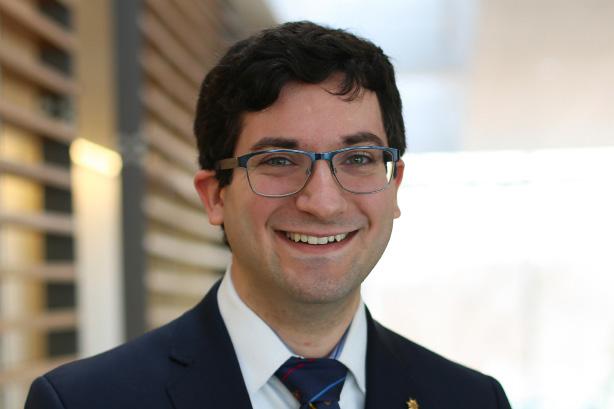
replace, human judgment and creativity.
“We need students to be able to look at an AI-generated response and say, ‘This isn’t accurate—and here’s why.’”
He explained that any
and accountability when AI tools are used—whether for research, grading, or coursework support.
Currently, Queen’s is in the early stages of building a university-wide approach to AI. The creation of the
Artificial Intelligence Framework, the institution is focused on supporting the ethical and effective use of AI while managing potential risks.
Rather than a single policy, Queen’s is taking a decentralized, consultative
approach. Individual faculties and departments have some flexibility in determining how AI is addressed in their teaching or evaluation policies. For instance, the Department of Political Studies prohibits the use of generative AI tools like ChatGPT unless explicitly permitted in the course syllabus. Unauthorized use is treated as a potential academic integrity violation.
Part of Soleas’s new role will involve coordinating these discussions, working with groups like the Digital Planning Committee, a committee made up of Queen’s Senior Leadership Team that works to prioritize that AI systems are implemented in a way that reflects the values and objectives of Queen’s University, and contributing to the development of an AI Centre of Excellence to ensure alignment across campus.
Soleas’s stressed that if used properly, AI has the potential to support the development of critical thinking, assuming that students are encouraged to question, critique, and refine the content it produces, rather than accepting it at face value.
Kingston home to Rainbow-registered businesses. PHOTO BY JASHAN DUA
Business, Science, and Technology Editor
Katarina Krivokapic
Lilly Meechan Assistant News Editor
Soleas will act as Queen’s Special Advisor on Generative AI for a two-year term. PHOTO BY JASHAN DUA
SPORTS
Three Gaels earn valuable CFL experience with Ottawa Redblacks
‘The opportunity was pretty unique and probably won’t come back around,’
Taahaa Lone Senior Sports Editor
When the CFL’s Ottawa Redblacks rolled into Kingston earlier this summer for a training camp at Richardson Stadium this spring, three Queen’s Gaels earned a shot at professional football—without even leaving campus.
Earlier this summer, the Redblacks invited three Gaels players to participate in their training camp as part of a new partnership with Queen’s. Each athlete was selected for one of three CFL programs designed to develop and showcase Canadian football talent, giving them valuable exposure to the professionalgameandatasteoflifeat the next level.
Queen’s Women’s Football standout player, Kallie St. Germain, ConEd ’27, joined the Redblacks’ coaching staff through the CFL’s 2025 Women in Football internship program. St. Germain is coming off a successful year with the Queen’s women’s football team, who were crowned 2025 OWIFA Cup Champions after an undefeated 11-0 season.
Although St. Germain spent most of her playing career on offense, her sights are now set on the defensive side of the ball. Under the mentorship of Redblacks Assistant Head Coach and Linebackers coach, Deion Melvin—who brings decades of coaching experience—she’s been learning the nuances of defensive football. In a statement to The Journal, St. Germain praised the entire Redblacks defensive staff for their roles in guiding her through this program. She also highlighted Redblacks star linebacker, Jovan Santos-Knox, as someone whose leadership ability made him a role model for her, and displayed lessons that she will carry in the future.
“Being around a professional team and feeling supported by the players and staff made me realize there’s real space for women in football. At the same time, it also showed me how much there’s still to learn,” St. Germain says. She added that she would love to pursue coaching in the future, and that she is grateful for the foundation that the Redblacks have laid for her.
***
Queen’s Men’s Football Defensive Back Coach and Special Teams Assistant, Thompson McCallum, ArtSci ’21, stepped onto the professional stage this summer, joining the
Ottawa Redblacks’ Scouting and Football Operations staff through the CFL’s Diversity in Football Program.
“The opportunity to work with a front office staff and the GM in the scouting department was something that I thought was pretty unique and probably wouldn’t come back around,” McCallum said in an interview with The Journal
For McCallum, the level of specialization—in scouting, coaching, and operations— paired with the scope and depth that professional front offices go through when evaluating players stood out to him during the program.
While not at the professional level, McCallum says his learning will directly translate to his work with Queen’s. “We’re running a program that’s similar to what they’re doing at the professional level. A lot of the similarities made me confident that the skills that I’ve gained here will be transferable to the future,” he said.
Overall, McCallum gained valuable insight from the experience—and Ottawa may pick up a tip or two from him as well.
“Having [the Redblacks] give me that recognition of ‘You bring up some really good points there,’ and just being able to sit down with them and talk ball. To know that my level of knowledge is not super far behind, I definitely have a lot more room to grow, but it was really good to have that feeling that I feel like I am on the right path,” McCallum said.
Gaels Quarterback, Alex Vreeken, Kin ’26, participated in Redblacks Rookie Camp and Training Camp through the CFL’s QB Internship Program. This unique program allows local U Sports quarterbacks to train with professional teams before they are eligible to be drafted the summer after their final university season ends. Notable alumni of this program include Taylor Elgersma of the NFL’s Green Bay Packers and Tre Ford of the CFL’s Edmonton Elks.
While Vreeken couldn’t provide a statement to The Journal in time for publication, the experience is sure to give him a professional boost as he enters his final season as a Gael—where he’s projected to start at quarterback after two injury-plagued years.
Continued online at www.queensjournal.ca
Queer athletes are changing the playbook on masculinity in sports from the international to the recreational level
It’s not their job, but 2SLGBTQIA+ athletes are changing the game through visibility, advocacy, and pride
Cloey Aconley Editorials Editor
From international podiums to local playing fields, sports are transforming into more inclusive spaces for 2SLGBTQIA+ athletes. Representation of 2SLGBTQIA+ athletes on the international stage has a powerful ripple effect, reaching all the way down to community sports leagues. For many queer youth, seeing athletes who share their identities helps make local sports spaces feel more welcoming and affirming.
Last summer, a recordbreaking 193 2SLGBTQIA+ athletes competed in the 2024 Paris Olympics, racking up an impressive 68 medals across all events. Despite the success of queer athletes on the international stage, homophobia in sports remains an issue rooted in toxic masculinity and a long history of conformity.
Since the very beginning of organized sports, the nature of the competitions has valued aggression and physical dominance, traits that are traditionally correlated with masculinity. As the popularity of organized sports boomed in the 20th century, athletics became a rite of passage for young men.
For the generation of male athletes who grew up on Rocky (1976) and Hoosiers (1986), sports were a way to gain social capital and reaffirm their masculinity. Continuing into the 21st century, hyper-masculine sports culture has enabled harsh responses to any deviation from the ‘jock’ stereotype, including homosexuality. Popularized “locker room talk” includedderogatoryslurs,creating a hostile environment for 2SLGBTQIA+ athletes. .
However, as 2SLGBTQIA+ athletes continue to excel on the international level, community sports are becoming significantly more inclusive, celebrating rather than shaming their queer athletes.
Queer Olympians such as British diver, Tom Daley, and United States distance runner, Nikki Hiltz, are bringing attention to sports’ history of homophobia by advocating for 2SLGBTQIA+ rights and donating to charities supporting queer youth—movements that are impacting the base level of sports and building the next generation of athletes up for success.It’srolemodelssuchasDaley and Hiltz who are creating inclusive spaces for queer athletes from the grassroots to the international level. Daley
has publicly condemned countries where homosexuality is punishable by death, and he has criticized the International Federation of Association Football for hosting the 2022 World Cup in Qatar. From denying migrant workers’ rights to anti2SLGBTQIA+ laws, the 2022 World Cup hosts received a plethora of backlash, bringing attention to the role of politics—especially topics centered on queer rights—in international sporting events.
During the COVID-19 pandemic, Hiltz began to reflect on their gender identity and lean into advocacy work. Hiltz organized their own annual run called the Pride 5k to create a safe space for queer runners and raise money for the Trevor Project, a not-for-profit dedicated to supporting queer youth.
To date, the Pride 5k has raised over $172,000 in support of the Trevor Project, according to their website.
Though it’s not their responsibility, queer athletes such as Daley and Hiltz are utilizing advocacy and fundraising to create an increasingly inclusive sporting environment, turning the page on a narrative that has traditionally enabled toxic masculinity.
Organizations like You Can Play and The Trevor Project are actively leading this shift—training coaches, promoting inclusion, and ensuring that community sports become safe spaces where young 2SLGBTQIA+ athletes can thrive. This work matters deeply, especially for those who don’t feel safe being themselves at home and instead turn to their teams and community groups for belonging and identity.
Notably, 170 of the 193 2SLGBTQIA+ athletes at the Paris Olympics were women. Women have been historically excluded from organized sports that were considered “too masculine.”
This history of exclusivity has fostered a subculture of resistance and solidarity within women’s sports, celebrating non-conformity and welcoming 2SLGBTQIA+ athletes.
While some female athletes, such as American swimmer Riley Gaines, have been outspoken in their opposition to 2SLGBTQIA+ inclusion, women’s sports as a whole has been historically a safer and more welcoming space for many queer women and non-binary athletes. In fact, women’s sports have often been at the
forefront of efforts to uplift and celebrate queer athletes
Though in 2025 male sports teams still struggle with exclusivity and toxic masculinity, they have come a long way in promoting acceptance and inclusion. Despite vaguely homophobic locker room rhetoric present at the local and international level, male athletes are often more accepting than you would expect given this history.
Equestrian athlete and founder of Outsports, a 2SLGBTQIA+ sports blog, Cyd Zeigler shared with NBC Sports that the level of acceptance in men’s sports is usually much higher than is perceived. Despite the hypermasculine and borderline homophobic jargon in men’s locker rooms, many male 2SLGBTQIA+ athletes feel supported and accepted by their teammates.
While homophobia still exists in sports, the growing visibility and advocacy of 2SLGBTQIA+ athletes is paving the way for an inclusive and accepting sporting community.
Though not always perfect, the positive influence of creating safe spaces for students can be felt here on campus—where 2SLGBTQIA+ athletes are beginning to find their community and a sense of pride.
Queen’s Athletics currently hosts a 2SLGBTQIA+ cycle class, and solidarity swims for queer students looking for a safe and comfortable space to swim.
However, Queen’s hasn’t always been active in supporting their 2SLGBTQIA+ athletes. In 2015, student athlete Donovan Hillary transferred schools following his experience of homophobia on the football team. Athletics and Recreation denied comment on the incident at the time, but in 2018, they renewed their commitment to Safe Sport policies, including mandatory inclusion training for all staff.
As awareness and representation of queer athletes increases, and traditionally masculine stereotypes are challenged, a new generation of athletes are looking up to modern superstars and beginning to view sports as a tool of self-expression rather than repression.
Where earlier generations may not have had 2SLGBTQIA+ representation in their sports, today’s young athletes see role models who proudly celebrate who they are.
Gaels Golf team swings strong at Nationals
‘I’m really proud that we got there, that we had a good experience,’ coach says
Taahaa Lone Senior Sports Editor
For the first time since 2018, both of Queen’s Golf Teams competed in Kamloops, BC, from June 3 to 6 at the Golf Canada’s Canadian University/College Championship. The event serves as the national championship for Canadian student-athletes, featuring over 20 schools and 150 competitors from across the country.
The men’s team made the cut for all four rounds, placing as high as third at the halfway point before slipping to seventh place with a +39. Their finish was first among all Ontario universities at the event, signalling improvement on an already remarkable bronze medal at the OUA Golf Championship in October.
Coach Jessie Mercer told The Journal in an interview that this is Queen’s best score relative to par since the competition’s inception in 2003.
On the other hand, the women’s team was competitive throughout most of the tournament but missed the cut for the final round. Finishing second among Ontario university teams, the Gael’s ended the
tournament with an +85, signalling growth for the reigning OUA Women’s Golf Bronze medallists.
Individually, the Gaels made their mark. Kiley Rodrigues, ConEd ’25, posted a +17—good for 10th place overall and the top finish among Ontario golfers. It marks Queen’s first top 10 result at the women’s tournament since Robyn Campbell, ConEd ’18, placed sixth in 2015.
For Rodrigues, this season marked a return to competitive golf after a few years away following her time playing in the U.S. “I was really excited to compete again,” she said in an interview with The Journal. “It was awesome to see the results and finish near the top. Having Jessie [Mercer] and the team behind me definitely helped me play better.”
On the men’s side, standout Daniel Abraha, Comm ’26, led the competition after the first round, ending with a formidable -1 to tie for 10th in the nation. Gaels Luke Macpherson, Sci ’26, and Kendrick Webster, Sci ’27, tied for 31st with scores of +13 each. Ryan Crowley, ConEd ’26, tied for 34th with a +14, and Alex Osborn, Comm ’27,

placed 50th with a +32.
For Queen’s Golf Head Coach Jessie Mercer, this is just the beginning. She explains that returning to Nationals for the first time since 2018 was a big step for the program, adding that consistent appearances help put Queen’s back on the national radar.
Mercer praised the camaraderie that her team displayed and credited them for upholding the team culture that is seen in all of the top teams at this level. She was proud of her entire team and highlighted the aforementioned Abraha and Rodrigues.
The coach also highlighted Kendrick Webster for finishing an up-and-down season with a strong showing on the biggest stage. While Mercer stayed humble, Rodrigues credited her leadership and the supportive team atmosphere as key to their success.
The Gaels Golf team kick off their next season at home, hosting the Bert Kea Memorial/Queen’s Invitational on Sept. 14.
Queer & Gender Diverse Student Athlete Association creates welcoming
environment for 2SLGBTQIA+ athletes at Queen’s
Club seeks to help 2SLGBTQIA+ athletes ‘in every way possible,’ club heads say.
Taahaa Lone Senior Sports Editor
At a time when the rights of 2SLGBTQIA+ athletes continue to be threatened, Queen’s Queer and Gender Diverse Student Athlete Association (QGDSAA) seeks to provide a space for 2SLGBTQIA+ athletes to build community. Founded in 2023 by former Gaels Women’s Hockey captain, Charlotte Melindy, ArtSci ‘25, the torch has been passed to the current Gaels volleyball stars Chris Zimmerman, ArtSci ’26, and Holly Biasi, ArtSci ’26.
“[The QGDSAA is] a space for 2SLGBTQIA+ student athletes to connect and share their experiences,” Zimmerman and Biasi wrote in a joint statement to The Journal. “Whether
it’s through casual movie nights, study halls, discussions about the unique challenges we face in sport, or guest speakers, our goal is simply to create a supportive environment where people feel safe to be themselves.”
The club fills a major gap that exists for 2SLGBTQIA+ athletes, the co-chairs explain.
According to Canada’s Sport Information Resource Centre, 67 per cent of all lesbian, gay, and bisexual athletes and 85 per cent of trans athletes surveyed experienced at “least one homophobic episode,” and as a result, “feel pressured to stay in the closet” or are excluded by their peers.
“Both of us have personal experience navigating our identities within our respective team dynamics,” Zimmerman and Biasi said. “It can be isolating and difficult. We want to help in every way possible to ease that process for all 2SLGBTQIA+ athletes on campus.”
In the upcoming school year, the co-chairs are working to expand its reach to queer students through campus partnerships and increased visibility. More specifically, the club plans to collaborate with the Yellow House Student Centre for Equity and Inclusion to better connect 2SLGBTQIA+ athletes with the broader community at Queen’s. The goal is to create events that foster a stronger sense of belonging and comfort for these athletes within the broader 2SLGBTQIA+ community.
“Generating more participation really just stems from creating awareness that outlets such as the QGDSAA exist,” Zimmerman and Biasi said.
For both chairs, their work with the QGDSAA feels like just the start of a broader movement toward greater inclusion and visibility in sport at Queen’s. As they look ahead, Zimmerman and Biasi hope their efforts will not only strengthen the
miles brackenbury to represent canada at fisu
summer World university games
‘I always just dreamed of representing my country on the international stage,’ athlete says
Taahaa Lone
Senior Sports Editor
From July 16 to 27, Gaels Distance Track runner, Miles Brackenbury, ConEd ’26, is set to represent Canada on the international stage for the half-marathon at the 2025 FISU Summer World University Games in Rhine-Ruhr, Germany.
As one of the largest multi-sport events in the world, Brackenbury will join over 8,500 student-athletes from over 150 countries competing in 18 sports for the World University Games. Canada hasn’t sent a team to the tournament since 2019 as the games were cancelled due to the COVID19 pandemic in 2021, and Athletics Canada declined to send a team in 2023 due to financial constraints.
Competing on the international stage has always been a dream for Brackenbury. “I always just dreamed of representing my country on that stage. You see how the world comes together at these kinds of international events and it’s such a powerful feeling,” he said in an interview with The Journal
“There were a couple of times where I was on the cusp of making an international competition. As you get older, you run out of junior teams. You’re no longer eligible for like a junior team, and as if it’s Olympics or bust,” Brackenbury said.
Tournaments such as the World University Games allow elite student-athletes like Brackenbury to have their hard work recognized and give them the chance to compete against elite athletes in an event with a scope only rivalled by the Olympics.
The road to this success
wasn’t easy for Brackenbury. A bout with ankylosing spondylitis—causing long-term inflammation of the joints and ligaments in the spine—sidelined him for six months last year.
Despite the setback from injury, Brackenbury returned and helped the Gaels win bronze at Nationals, and this comeback inspired him to keep aiming higher. “I saw this opportunity and I said I have to give it a go. We wrapped up our indoor track season, and I had a month to prepare for the half-marathon,” he said.
Brackenbury travelled to Montreal compete in the 21K de Montreal with the goal of breaking through FISU’s half-marathon entry standard of 1:10:00. He finished third in the event with a 01:09:01, and a couple of weeks later, it was official— Brackenbury would represent Team Canada on the international stage. “I couldn’t believe it. It was like a dream,” he said.
“I’m excited to go to [World University Games] and represent our country, and no one got there alone. We often focus on the individual, but that individual is propped up by their upbringing, by their teachers, mentors, friends, and family,” Brackenbury said.
Yet, there is one large obstacle athletes face in attending FISU-organized events according to Brackenbury— money. “It’s hard when people then need to also financially support that athlete because not everyone has the same means,” he said. In light of the financial burden associated with attending the event, Brackenbury decided to start a GoFundMe to help him compete at the international stage.
Continued online at www.queensjournal.ca
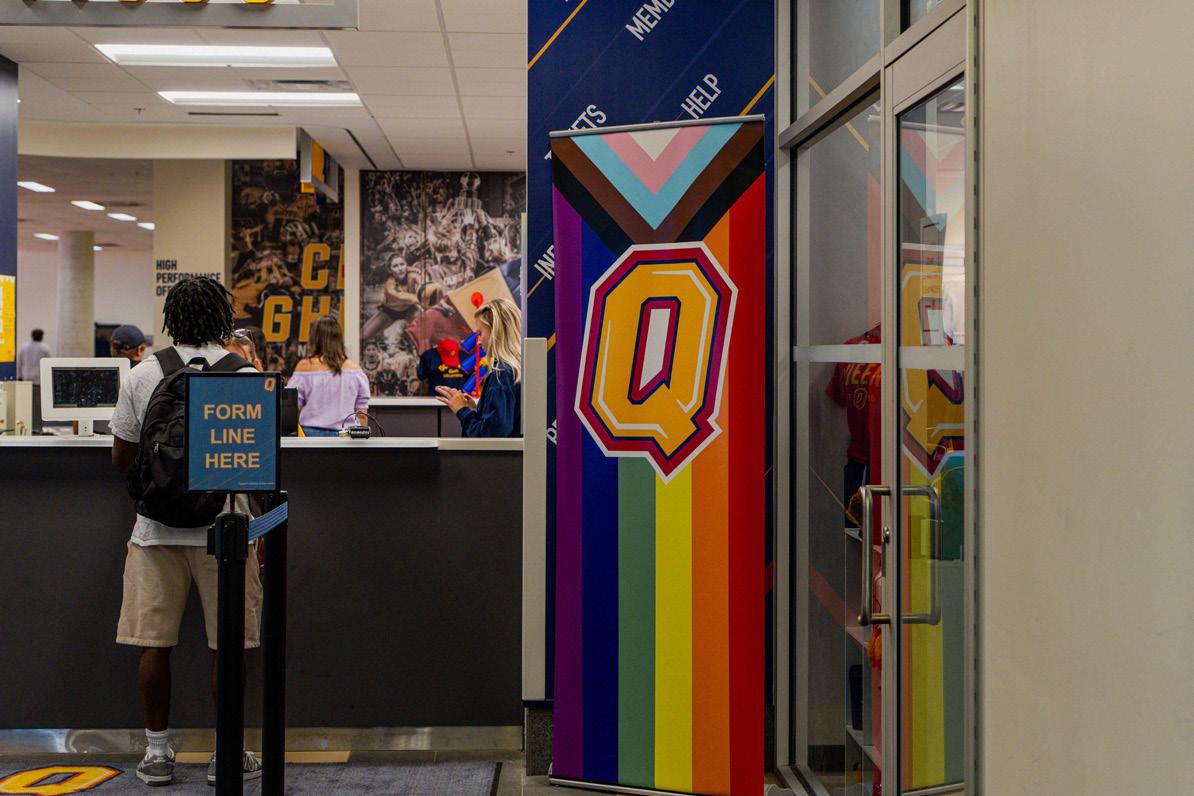
QGDSAA but also help shift the culture of sport at Queen’s toward one that celebrates and supports all identities. By building community and visibility, they’re laying the groundwork for lasting change—on campus and beyond.
QGDSAA continues to cultivate a welcoming environment for 2SLGBTQIA+ athletes.
PHOTO BY JASHAN DUA


Aries (Mar 21- Apr 19)
Dreamy planet Neptune is in your sign, causing you to set your sights high. That ambitious Aries spirit may be driving you to new heights, but beware of over extending yourself and missing what’s right in front of you. Attend to the people closest to you before you try to save the world.

Gemini (May 21- Jun 30)
Music, poetry, the arts—lose yourself in your imagination this week and let creativity fuel your future ambitions. You have a lot of things cooking right now (When do you not?). Follow an abundant birthday season with a creative start to your very own New Year.
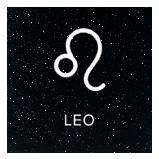
Leo (Jul 23- Aug 22)
You may not have been seeing the immediate results of your efforts lately, but this is because you have been sowing the seeds for far-reaching plans that will pay off handsomely in time. Hold out for a late-summer harvest. Good things are on the way!

Libra (Sept 23- Oct 23)
Ruled by Venus, your romantic sensibilities are well-adjusted. Be realistic with what you expect from others, but don’t settle! Ideal friends and lovers will match your spark and interest in beauty. Continue being your authentic self, and you will attract companions of the same caliber.

Pisces (Feb 18- Mar 20)
A sudden insight into an unconventional source of income will spring to mind this week! Your creativity is one of your greatest strengths, Pisces, and it is okay if nobody else understands. You may have noticed an opportunity which others have missed, and you will be richer for it. Pursue this to the end for a great reward!


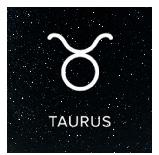
Taurus (Apr 20- May 20)
You may find yourself tending more to the home this week, which is a great way to strengthen bonds with loved ones. Distance makes the heart grow fonder, but sometimes some classic one-on-one time can renew longlasting connections.

Cancer (Jun 21- Jul 22)
If you’re feeling unappreciated in your current job, friend group, or routine—LEAVE! The best time to make change is always yesterday, but the second-best time is right now. Your stubborn and sentimental crabs tend to entrench yourselves in unforgiving environments. Don’t “stick it out” this time, you’ll regret it.

Virgo (Aug 23- Sept 22)
Spitfire Mars rips through your sign, stirring action and conflict. Ironically, you’re at an impasse. Torn between opposing viewpoints, paths, or opinions, your cautious and analytical nature will prevail and help you choose the right set of next steps. Trust your intuition.

Scorpio (Oct 23- Nov 22)
You’re being fussy about a major project or ambition and it’s blocking your success. You’re a water sign. Go with the flow, follow your emotions, and let your passion for every aspect of your life draw you to what’s important, helping you take those crucial first steps forward.
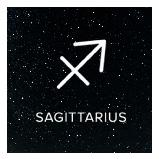
Sagittarius (Nov 23- Dec 21)
You’re sometimes considered the most relaxed fire sign, but your temper is still prone to flare-ups. Watch out for conflicts of opinion that spark bigger debates and arguments. These are unnecessary! Summer’s hot enough. Put your ego aside and let cooler heads prevail.




HOROSCOPES

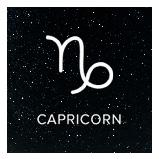
Capricorn (Dec 22- Jan 20)
You can be extremely critical and deeply loyal at the same time, which confuses your friends. Keep


the “tough love” ratio in check this week. You may consider it a delicate balance, but your loved ones are experiencing emotional whiplash and are ultimately pulling away.
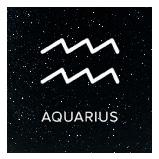
Aquarius (Jan 20- Feb 18)
If something weirds you out, Aquarius, it may not be trustworthy. As lifelong lover of the esoteric, you are generally open minded and embrace what others balk at. Your sixth sense may be tingling at a certain relationship, conversation, or individual in your life. This is a sign that things may be more nefarious than they seem.
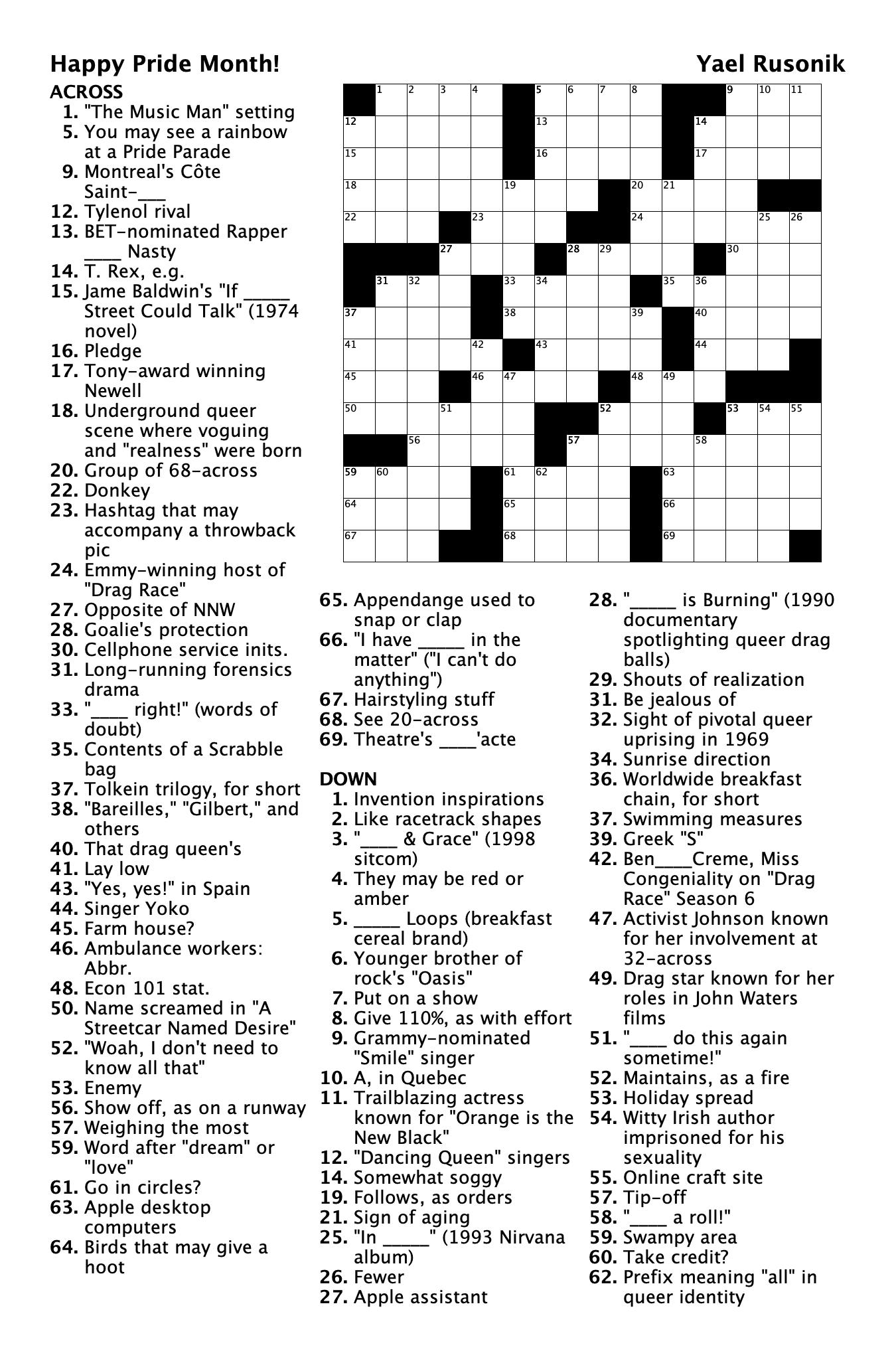






ARTS & CULTURE
Kingston hosts 20th annual Skeleton Park Arts Festival
Art, music, and community over the solstice weekend
Marijka Vernooy Senior Arts & Culture Editor
It takes a lot to drag Kingstonians away from their air conditioning units during the summer, but this year’s Skeleton Park Arts Festival (SPAF) certainly brought the heat.
As temperatures soared during last weekend’s summer solstice, artists, musicians, and creatives of all ages flocked to McBurney Park to attend SPAF’s 20th annual event.
2025’s program featured a variety of musicians, local food vendors, and artists as part of the Fat Goose Craft Fair. Wandering the colorful booths on Sunday afternoon, The Journal spoke with vendors about their experience at SPAF.
First-time SPAF vendor
Danielle Prophet owns The Natural Tannery and discovered the festival through Instagram. Using bark, natural fats, and smoke, she tans hides and teaches classes in Perth, ON. “I’m here to remind people how nice it is to be tactile,” Prophet said in an
interview with The Journal. “It feels really important”.
When asked about her experience at SPAF, she laughed and gestured to the nearby mainstage, where a band played to a lawn full of festivalgoers. “I love live music and community vibes. I’ve [often] left my booth to go dance and listen.”
While the music and community draw many, SPAF also highlights local artists in other ways.
Kingston-based comic artist Colton Fox’s series Witch Hazel is featured as a full-page installment in the most recent edition of SPAF’s The Skeleton Press. free newspaper focuses on the Skeleton Park neighborhood and surrounding parts of the city.
Fox described SPAF as a great space to meet local creators. Because of its accessibility to artists of all stripes, it’s particularly suited for artists who are just starting out.
“I recommend [SPAF] to new creators”, Fox said in an interview with The Journal.
Lingering by the mainstage, The Journal caught Lee Taylor,
Kingston events explore queer art as activism
Collages, buttons, zines, and a history of radical self-expression
Amid the prominence of digital media in Queer spaces, recent events around Kingston show that physical art remains an important medium and powerful tool for queer expression and activism.
While Pride Month brings added visibility to queer issues, events like the Agnes Etherington Art Centre’s monthly Queering Collage Series from June 8-22 and on June 12 the Kingston Frontenac Public Library presents Create and Resist! in partnership with Kingston Pride—highlight that queer artistic expression in Kingston extends far beyond June. These ongoing programs highlight the lasting power of physical art as a tool for creativity, activism, and community connection for both Queen’s students and the wider queer community in Kingston.
For Alyssa Vernon, ConEd ‘22 and founder of the Queer Collage Collective (QCC), creating physical art is a meaningful way to honour the history of Pride as a protest and
ArtSci ’78, and Liam Vachon O’Hearn, MA ’25, of Kingston’s retro-pop brass band Brass Over Tea Kettle unwinding after an electric set in the midday heat. Formed just over a year and a half ago, this is the band’s first time performing at SPAF. Taylor described the festival as a “bit of a bucket list item. We’ve been to [SPAF] before and thought, ‘that would be a good fit for us.’”
Vachon O’Hearn had positive things to say about the band’s experience this year. “The food vendors are incredible. The arts and crafts are meticulously handmade, crafted locally. It’s really nice to see music uplift the community. It’s a fantastic place to be.”
Last week, SPAF Artistic Director, Greg Tilson, met with The Journal to reflect on the festival and its future. Tilson highlighted SPAF’s commitment to blending national acts with emerging local talent—like Polaris Prizewinner Cadence Weapon, performing just hours after local indie artist Almond Milk.
Overseeing all programming, Tilson recalled the festival’s grassroots roots, from its start as a neighborhood music event 20 years ago to today’s large-scale arts
fair drawing crowds from across Kingston and beyond. The weekend kicked off with an unforgettable open mic night featuring acts like an Scottish bagpiper, a harpist, and even a live chicken chirping into the mic—moments Tilson calls unlike anything he’d ever seen. “I always know how long I’ve lived in Kingston”, Tilson jokes, given he has been involved with SPAF since the very beginning. When Tilson moved to Kingston 20 years ago, The McBurney Park Neighborhood Association hosted a “Solstice Picnic”, which he and a community of neighborhood creatives eventually developed into SPAF.
Continued online at www. queensjournal.ca
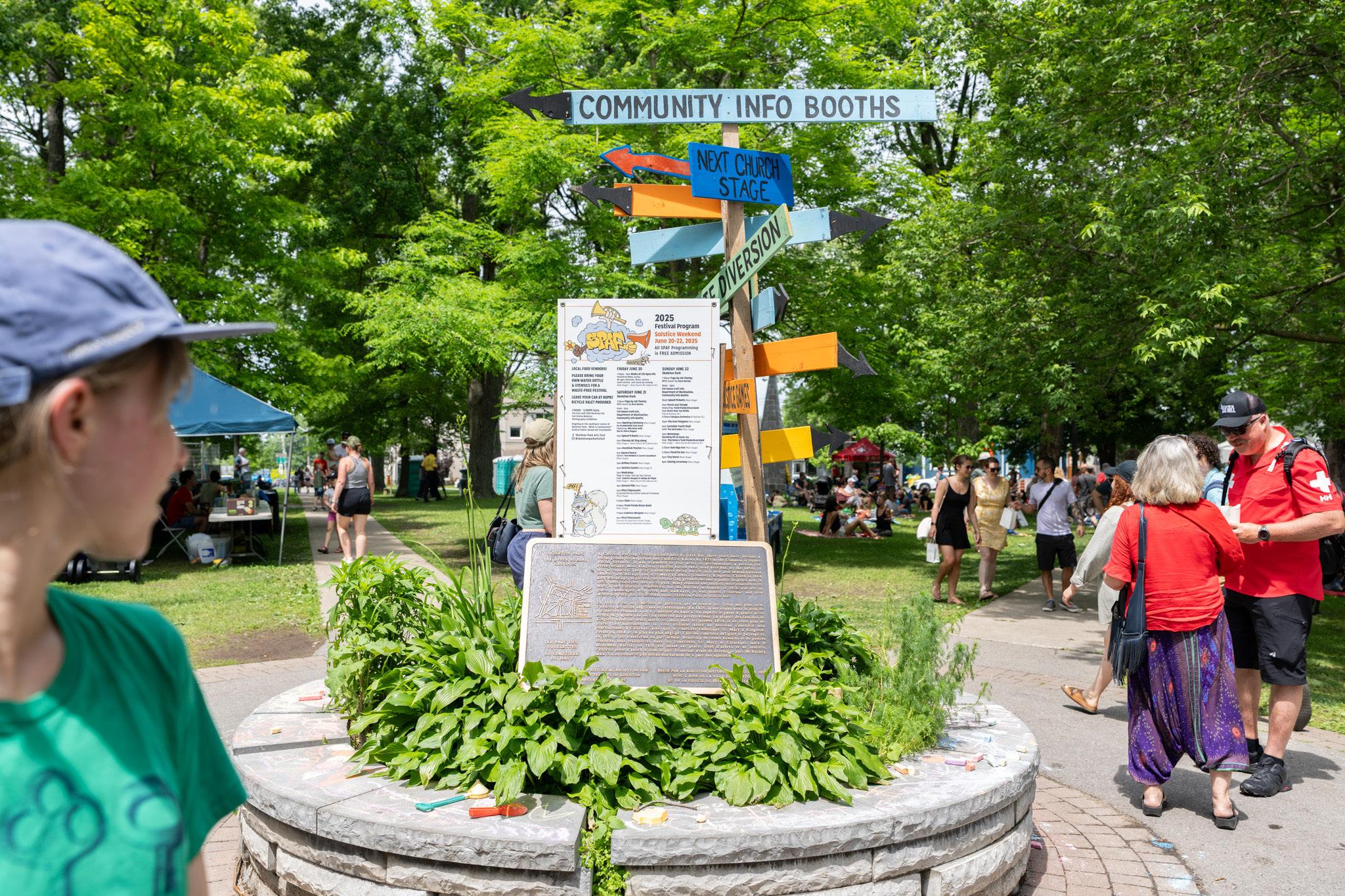
rebellion. After leading individual workshops in previous years, Vernon launched the Queering Collage workshop series at the Agnes Etherington Art Centre in fall 2024. This June, the series is expanding with two additional sessions to commemorate Pride Month.
The workshops this month
queer people, while zines have historically been used by queer communities to spread awareness and information that is continually ignored in mainstream media, news outlets, and even educational institutions,” Vernon wrote in an e-mail statement to The Journal.
Amidst the
art has the power to remind people of queer truth.
“Queer people have long used physical art to represent Queer history, trans experiences, lesbian and gay rights, the AIDS epidemic, practicing safe sex, and many other queer topics,” Vernon said.
On June 12, physical
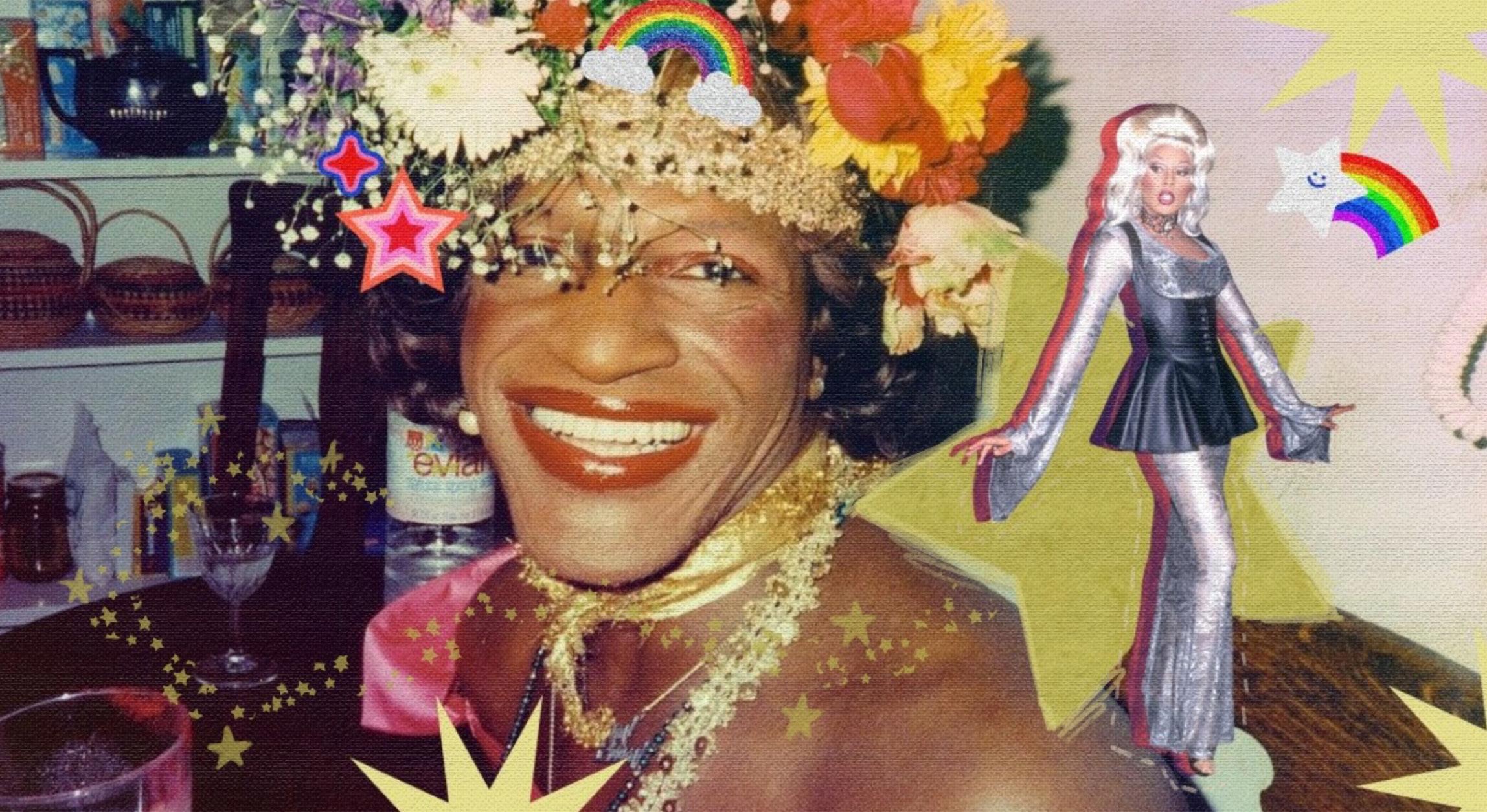
are focused on button and sign-making on June 8, as well as zine-making on June 22. “Buttons and signs are ways for us to communicate visually our demands as
prevalence of rainbow washing by corporations—a superficial and performative marketing tactic in support of the queer community during Pride month— Vernon says that
art extended beyond Queen’s ivory towers, as the Kingston Frontenac Public Library hosted Create and Resist!, a Pride Month workshop led by local queer artists SpiderWebWorks and
LGBteaQ_Creations. After a brief introduction to the role of zines, buttons, and other physical art forms in queer activism, participants created their own pieces to take home.
Workshops like Queering Collage Series and Create and Resist! remind participants of the personal and historical power of handmade art to queer communities. Through the creation of buttons, zines, and signs, participants not only celebrate queer identities, but also engage with the activist roots of Pride. As Vernon states, partaking in physical art forms can remind us that, “no one is free when others are oppressed.”
Beyond Pride month, Queen’s students can continue to participate in Queering Collage Series, which will resume in Sept. 2025.
All roads lead to fun at SPAF.
PHOTO BY JASHAN DUA
Assistant Arts & Culture Editors
Physical art creation events run from June 8 to June 22.
PHOTO SUPPLIED BY ALYSSA VERNON
Nadia Garcia, Daniel Gill
Office of Indigenous Initiatives hosts Elder Talk series
‘Today, it’s good that we’re here. We should be able to teach our mindset,’ says Cultural Advisor
Marijka Vernooy Senior Arts & Culture Editor
During 2025’s Indigenous History Month, the Queen’s University Office of Indigenous Initiatives is hosting a series of monthly Elder Talk sessions with Cultural Advisor Te ho wis kwûnt, Allen Doxtator, also known as Al.
Al is from the Onedia Nation of the Thames and is a member of the Bear Clan.
On June 16, Al sat down with participants for the first session of the series to discuss Indigenous culture, teachings, and mindset. The Welcoming Room in Mackintosh-Corry Hall was bright and inviting as Al spoke about the intertwined relationships between patterns of teaching influence patterns of thought.
“Mindset is based on our culture and our teachings,” he said. “Culture is value. Teachings [are] value. Mindset is value,” Al said during the session.
“An Indigenous mindset promotes [the] broader picture.” Al said in the session. “Everybody matters. Everybody’s ideas matter.” Historically, to participate in colonial academia, First Nations Peoples had to renounce their Indigeneity under a process known as enfranchisement. “Our values have been lost due to [trauma]. For us, it’s difficult to adjust,” he said. “Today, it’s good that we’re here. We should be able to teach our mindset”.
A large portion of Al’s discussion emphasized the difficulty of adopting the Indigenous mindset in an academic setting, where students are generally encouraged to think of things as having a single, unchanging solution. Al describes the difficulty of adopting the Indigenous mindset as tunnel vision. where new ideas are approached with criticism first and understanding second.
Growing up, Al was taught that adopting the
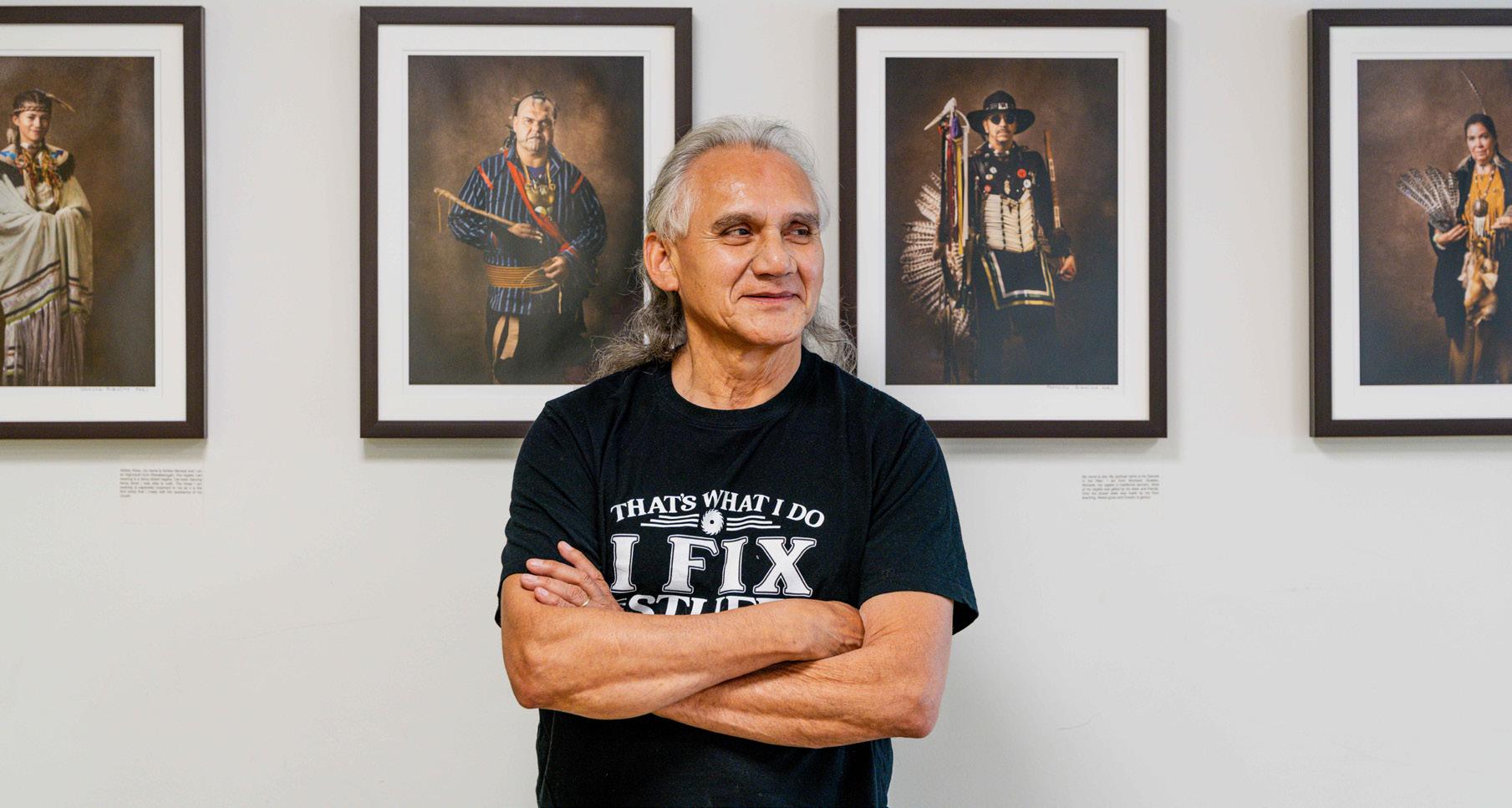
colonial mindset in Canadian schools would allow him to make the world a better place. He continued by explaining how he has seen the word destroyed, citing rising levels of pollution in local areas like the St. Lawrence River and government inaction involving environmental stewardship.
Al also emphasized the importance of embracing an Indigenous mindset for both Indigenous and nonIndigenous learners, regardless of cultural background. “When
we can understand our teachings, we as Indigenous people can look at others as human beings. When you see someone as purely human, you have a base relationship,” he said.
When it comes to academic institutions, Al affirms that Indigenous teachings need to be brought into this place.
“We [must] change our own mindsets. That’s what it is.”
When alone it’s easy to feel powerless to make change, but Al encourages students to “say what’s on your
mind. Talk out of turn.” The more we are exposed to different aspects of culture, teachings, and worldviews that are not our own, the better. “That’s what we should be doing—broadening the mind.”
The next session in the Elder Talk series will take place on July 10 and will focus on Honouring the Land—Connection, Respect, and Preservation.
ReelOut Film Festival celebrates 15th year of free Pride screenings
Trans-focused documentary Heightened Scrutiny played in Downtown Kingston
Nadia Garcia Assistant Arts & Culture Editor
It’s that time of year again when ReelOut delivers free Pride screenings to Kingstonians— this year, with a bit more of a twist.
On June 19, ReelOut Queer Film Festival celebrated its 15th anniversary of providing Kingston with free Pride month screenings with a showing of the documentary Heightened Scrutiny.
Directed by Sam Feder, an American filmmaker whose works include the 2SLGBTQIA+ documentaries DISCLOSURE (2020) and Boy I Am (2006), Heightened Scrutiny follows the journey of Chase Strangio, a transgender attorney for the American Civil Liberties Union (ACLU), as he fights in the United States v. Skrmetti case to declare Tennessee’s ban on gender-affirming care for trans youth unconstitutional. The film features interviews with trans youth and adults who reflect on how their daily lives are shaped by transphobic attitudes and polices.
ReelOut, the decision to choose this film was reflective of the festival’s acknowledgement of the discrimination that trans youth have
members of the 2SLGBTQIA+ community are fighting for their lives and their freedoms,” Salton said in a written statement to The Journal.
Salton expressed that accessibility is a year-long priority for the festival.
“We all need to be mindful of anyone who feels they
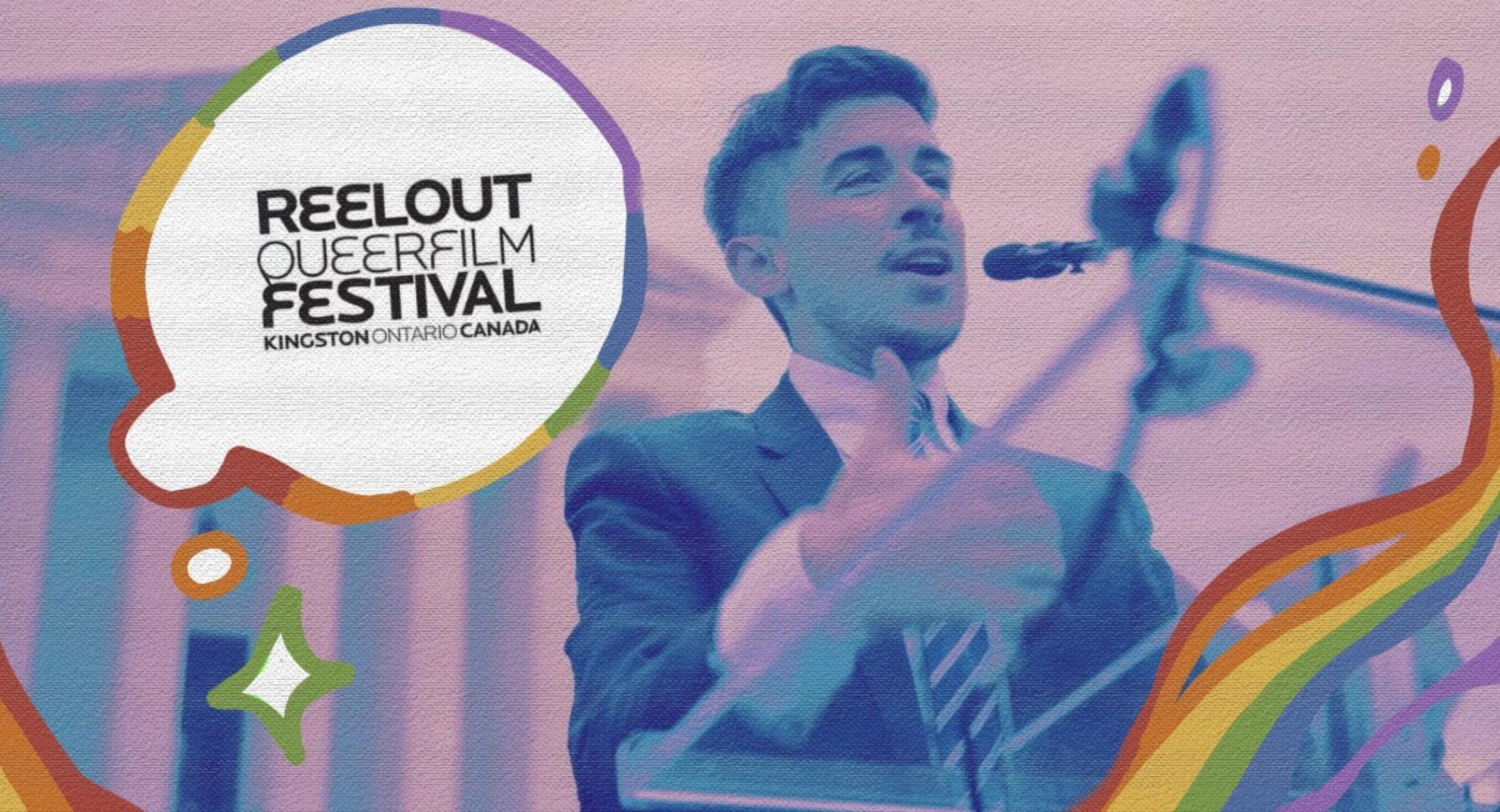
recently faced in the United States. The choice was made in collaboration between staff at ReelOut, the Downtown Kingston Business Improvement Area (BIA) and Kingston Pride.
For Matt Salton, executive director of
“For the most part, we’ve always screened something silly and fun, but it seemed pretty tone deaf to use such a large platform—literally and figuratively—for something frivolous when certain
The decision to select Heightened Scrutiny because of its connection to real-world issues is demonstrative of ReelOut’s mission to provide representation for 2SLGBTQIA+ communities by showcasing a diverse selection of queer films. This goal has long been fulfilled through the festival’s collaboration with Queen’s University, as well as its community-based initiatives.
can’t attend due to financial, physical, or emotional barriers,” he said. “ReelOut use[s] donations from the public and private sector sponsorships to leverage all the complimentary tickets we give out.”
The selection additionally marked importance because of Heightened Scrutiny’s critique of the rise of anti-trans rhetoric in the mainstream media. Sam Feder expressed in a 2024
interview with Sundance Film Festival that these attitudes, often present in speculations about the ethics of gender affirming care, have had the power to inform antitrans legislation—an important connection to keep forth mind when considering both the United States’ and Canada’s attacks on the rights of trans youth.
With many trans people facing widespread prejudice, including exclusion from sports and exclusion under the law, Heightened Scrutiny offers a much-needed counter-narrative that focuses on how this prejudice directly impacts the livelihood of transgender people. By ensuring accessibility toward the promotion of 2SLGBTQIA+ stories this Pride month, ReelOut has once again demonstrated the power of film in connecting communities and portraying marginalized stories—a legacy that has held true throughout the Festival’s 15 years.
Allen Doxtator at the June 16 Elder Talk session.
PHOTO BY JASHAN DUA
Trans youth at the forefront in this year’s screening.
PHOTO SUPPLIED BY MATT SALTON
Kingston Hidden Artist Collective reveals a creative community of under-priveleged local talent
‘The arts community in Kingston extends beyond formal institutions [and] campus galleries,’ says CoFounder Mara Fraser
Marijka Vernooy Senior Arts & Culture Editor
For some individuals, a piece’s journey from artist to audience may not be straightforward.
While Queen’s students may be used to appreciating art as part of on-campus galleries and exhibitions, they may not be aware of the rich community of Kingstonbased creatives that make up the city’s vibrant tapestry of visual art.
The Kingston Hidden Artists Collective (KHAC) emerged out of necessity, says Co-Founder, Mara Fraser. Fraser and her co-founder, Ali Sheik, created KHAC in Aug., 2021 after witnessing a community need among under-resourced artists who struggled to share their work.
“We saw so many incredibly talented artists who were unable to advocate for themselves—often due to poverty, housing insecurity, disability, mental health struggles, or challenges related to addiction. Their voices and stories were going unheard”, Fraser said in a written statement for The Journal
KHAC recognizes artists not for their formal training, but for their resilience and unique story given the barriers they face. “If someone has talent and a need for community and support, we want to amplify their voice,” Fraser said. “The arts community in Kingston extends beyond the walls of formal institutions or campus galleries. There is [an] often unseen, creative ecosystem of people [who are] frequently excluded
from mainstream spaces.”
Through their website, KHAC markets, sells, and delivers prints and merchandise created by ‘hidden” artists in disadvantaged situations, with hidden artists receiving 100 per cent of online profits.
“We connect with artists primarily through word-ofmouth and referrals from local housing programs, shelters, street outreach workers, and social service agencies”, Fraser says. Reflecting on KHAC’s growth, she says her full-time work at Home Base Housing—a non-profit organization that provides a range of supportive housing programs in Kingston—has bolstered outreach.
“The frontline staff at Home Base [Housing] often refer individuals that they think might benefit from KHAC. It’s really about meeting people where they are—helping artists create on their own terms and in their own space,” says Fraser.
In addition to online sales, KHAC is a key contributor to arts-focused hubs of activity in Kingston, such as pop-up markets and fairs. On June 21, they appeared at the Princess St. Promenade and have artwork on display and for sale at City Hall.
“Selling art in person gives me the opportunity to share the stories behind the work. These in-person events build meaningful connections between the artists and the community,” Fraser said. “They’re often just as valuable as the sale itself.”
Georgina Morey, an artist whose profile is featured on KHAC’s website, started drawing six years ago.
“I’m obsessed with it”, she says. “It’s a passion I didn’t know I had, to be honest.”
At the height of the COVID-19 pandemic, Morey was forced to leave Verona and walk to Kingston with her dog, Kane. After struggling to find housing ,she eventually found sanctuary at HomeBase’s “In From the Cold” adult emergency shelter where she met Ali Sheik, co-founder of KHAC.
“[Ali] invited me to a showing and said, ‘Come whenever you want. It’s your night, after all.’ From then on, I was like, ‘Oh my god, I’m having a night!’ It gave me a lot of confidence,” Morey recalls.
Morey’s piece, Warm Travels, was inspired by a walk she took with Kane. “[Art] brings me a bit of peace. It puts me in a state where I kind of forget about everything.”
For Mara Fraser, the real purpose of KHAC is “To reduce isolation, foster pro-social engagement, and build community through accessible and inclusive arts programming. The opportunity to share these stories is something I take very seriously. It’s a privilege to do this work,” she said.
“My biggest advice for young people—especially those unsure of their next steps—is [to] be useful. Find ways to be of service. You don’t have to have all the answers to make a meaningful impact.”
Fraser admits it’s hard to be a young person finding your way in the world and it’s hard to be a person, period. “But we’re better when we show up for each other.”
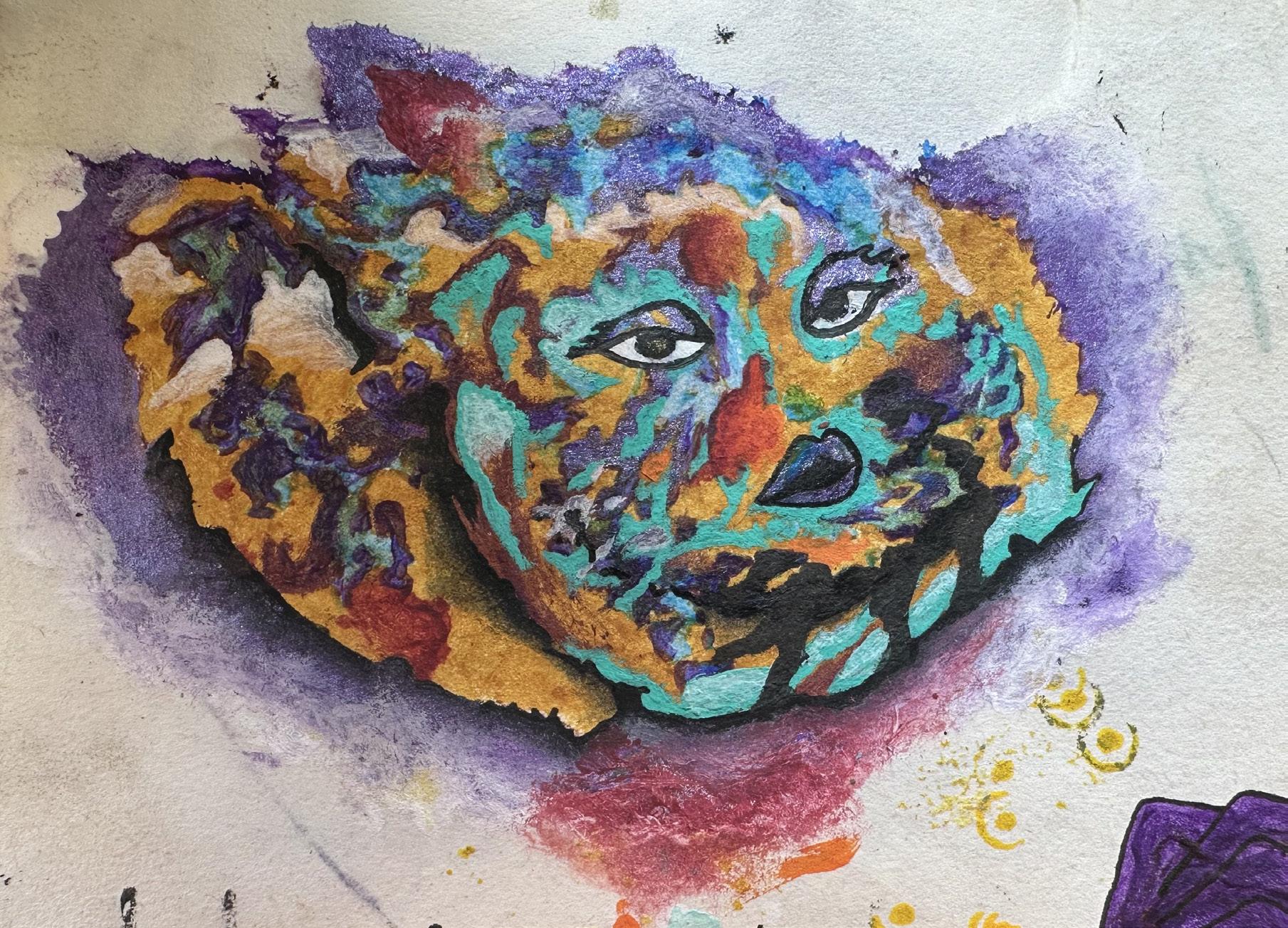
noW! that’s What i call Drag! lights up the graD club for charity
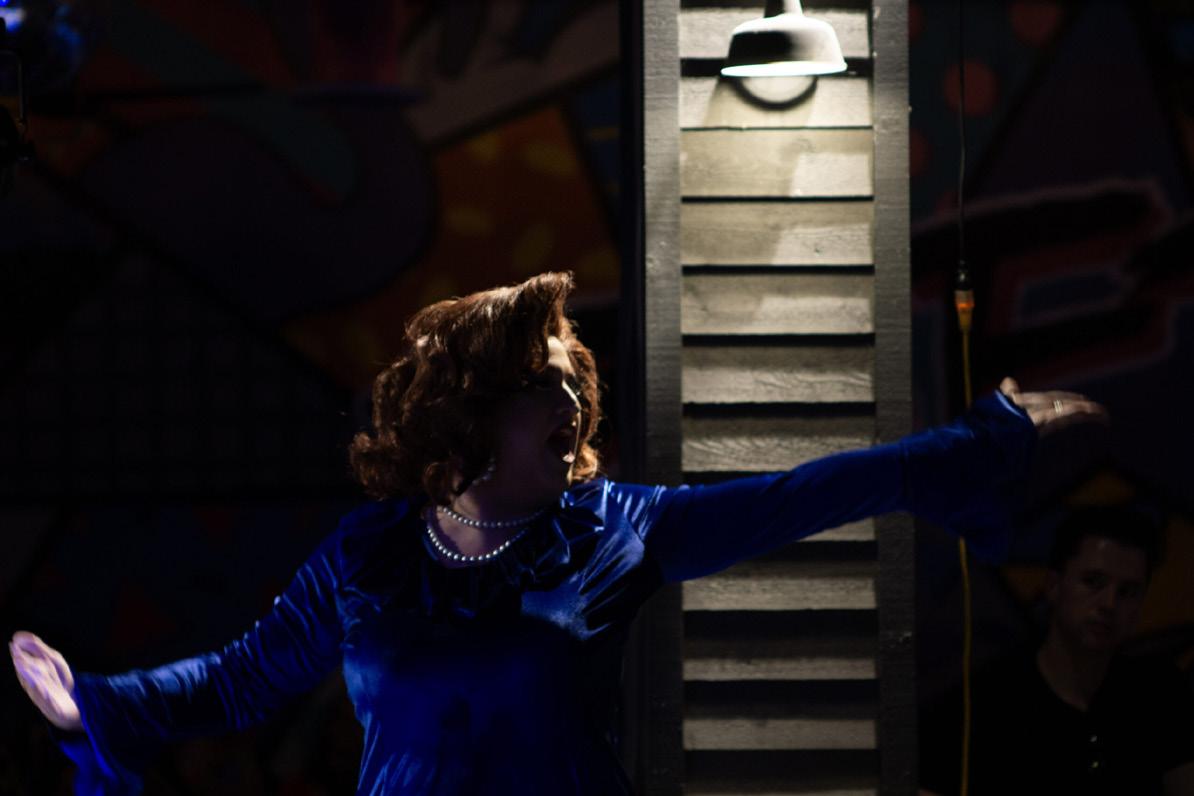
stage.
Yuni Verse’s 90s-themed drag show raises funds for Trans Family Kingston
Lights! Camera! Drag! at the Grad Club this Pride month.
On June 18th, the Grad Club turned back the clock, hosting a 90s-themed performance of NOW! That’s What I Call Drag.
Proceeds support Trans Family Kingston (TFAM), an organization that provides support and community for transgender and gender diverse individuals in the Kingston area. TFAM offers guidance on how to access necessary health and legal care, including gender-affirming services and name changes.
Yuni Verse, a trans drag queen based in Kingston, took to the stage as hostess, marking her second performance at the Grad Club andherfirsttimehostingafundraiser for TFAM. For the Grad Club, this fundraiser is another addition to a long history of providing queer artists and community members with safe spaces to perform and connect. to Pride Week celebrations and community fundraisers.” The Board called its drag shows some of the Club’s most “beloved and popular events.”
According to the Grad Club Board, their “collaboration with TFAM has recently become more direct and exciting.”
By hosting this charity event, the Club will support TFAM’s mission of providing the transgender community in Kingston with resources and support, including aiding with access to gender-affirming care.
Transgender individuals in Kingston have long faced barriers to genderaffirming care, including lengthy wait times and clinical descriptions of gender being limited to binary “male-female” language. and dismissal from medical professionals. For residents of a city that in recent years has reported the highest rates of transgender and non-binary people in Canada, this lack of access can have serious impacts on wellbeing.
For Yuni Verse, TFAM’s mission of supporting trans people and their medical needs is a cause close to her heart. “I personally wouldn’t be where I am today in my transition without their guidance and support,” Yuni Verse wrote in an e-mail statement to The Journal. For her, organizations like TFAM are essential to help provide the trans community “with the resources and support necessary to navigate the world.” TFAM declined to provide The Journal with a comment on their collaboration with the Grad Club and Yuni Verse.
Aside from benefitting TFAM’s services, NOW! That’s What I Call Drag! also demonstrates the power of personal artistic influences on drag performances and their connection to social activism. Yuni Verse shared that her performance’s 90s-inspired themes are a tribute to the decade’s celebration of“socialjusticeandnon-conformity,” and that her drag persona honours her transition to “becoming [her] true self.”
Queer-centered celebrations of identityareessentialpartsoftheGrad Club’s mission to serve as a space for queer performances and community events. For the Club’s Board, the “immense and loyal support” they receive from members of the queer community during Pride month are “fundamental to who we are.”
The Club continues to honour their commitment to the Kingston 2SLGBTQIA+ community with their monthly Open Stage Drag Night, which continues to captivate audiences all year long.
KHAC artist’s work.
PHOTO SUPPLIED BY MARA FRASER
Nadia Garcia Assistant Arts & Culture Editor
Journal File Photo Drag queen lights up the
From ponytails to buzzcuts: My hair’s role in self-discovery and sexuality
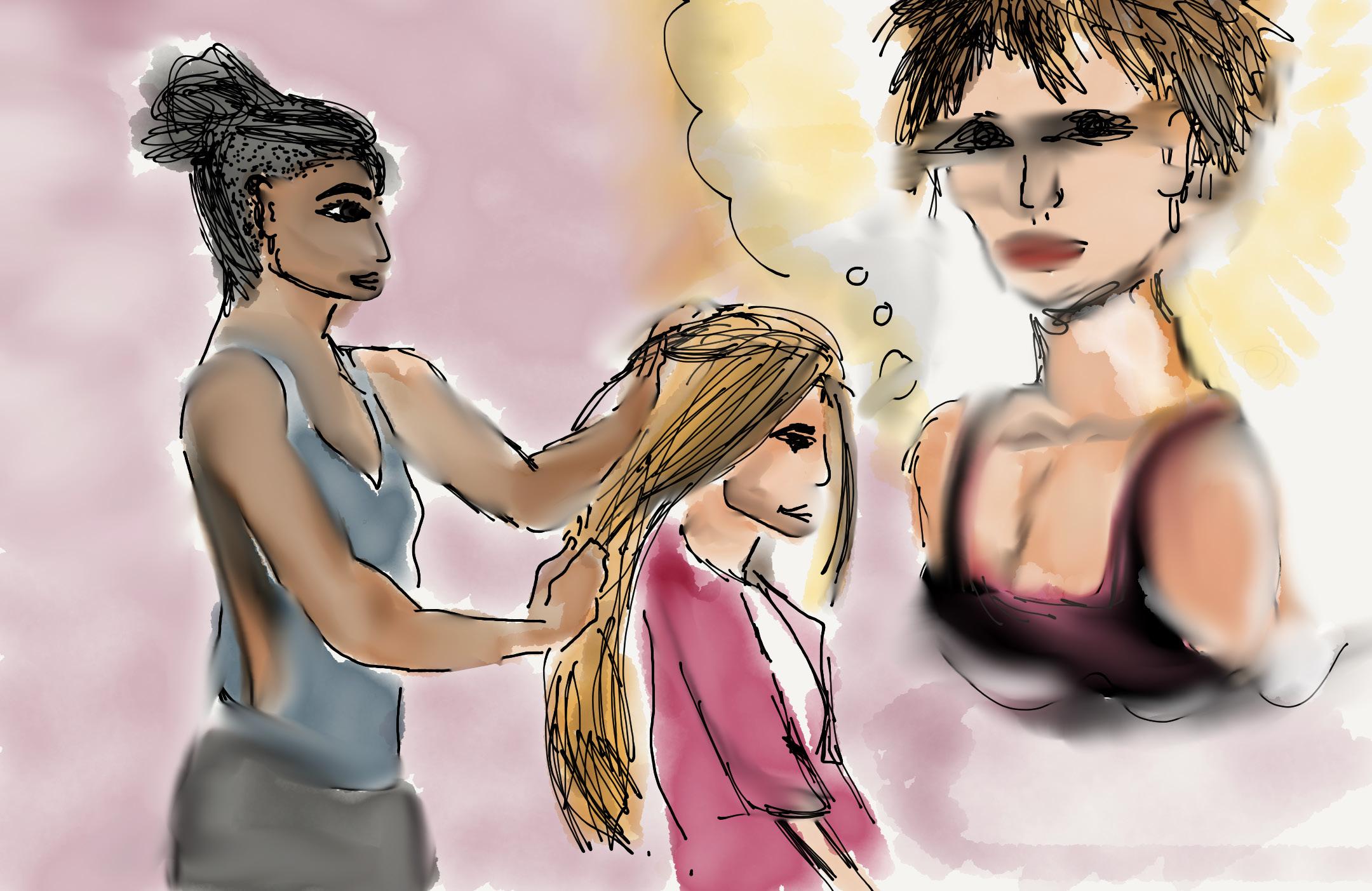
Eden’s hair marked key moments in her journey with gender and sexuality.
Somewhere between long curls and a shaved head, I became who I am.
Eden Natovitch Contributor
Coming to terms with my sexuality has been a dynamic self-exploration, with my hair as a constant reflection of who I am and how I wish to be seen.
When I was ten, I started to explore my gender identity and masculinity. I began shopping in the boys’ section and tucking my ponytail into my baseball cap. That summer at sleepaway camp, I told everyone to call me Ayden. With everyone around me knowing me the way I chose to present myself, the camp felt like a controlled testenvironment for my gender identity.
“At the beginning of my second year, I asked my sister to cut my hair short on a whim
When I returned home to Thornhill, being called my given name, Eden, felt unfamiliar but correct. I let my hair out of my hat, put on leggings, and felt like I was discovering who I was all over again. During that time, my long curly hair reminded me that I’m the girl I was born to be and that Ayden was a
phase best left behind.
Almost immediately, I was embarrassed and ashamed of my summer as Ayden. For years after, hearing the name or seeing a photo of ten-year-old me in a tie surrounded by my friends in dresses put a pit in my stomach and made me want to cry.
Despite this, I knew there was something different about me now. At eleven years old, I realized that I was lesbian. I was secure in my identity as a girl, but I would still beg my mom to let me get short hair, but she would always tell me that I could cut it when I was older.
Reluctantly, I kept my hair long.
As I started high school, the boy drama seemed fun, and I wanted to be the centre of someone’s gossip, so I thought I could be interested in boys too. I was intent on maintaining my social status, and despite wanting to cut or dye my hair in various fun ways, the fear of being too different would hold me back.
I feigned heterosexuality for most of high school, but in grade 12, I came out as bisexual.
Coming out wasn’t such a big hurdle for me because I’m lucky to have a very supportive family. My mom, a wedding officiant, often came home with stories of the adorable lesbian or gay couple she married, so I knew she would be accepting. My parents and siblings have always made it clear that their love is unconditional, and we’re very close, and since we’re so close, telling them about this part of me felt necessary
and simple.
With the support of my family as a foundation, I felt ready to take the next step and share this part of myself with the world.
Telling close friends during first year felt liberating. I grew to love the feeling of being a little different, rather than fear it. Still, I was growing into this feeling and moving to Kingston felt like enough change for one year. Being openly queer also affirmed my identity so I didn’t feel like I had to display it visually as much; I was comfortable with my having long hair.
“I
grew to love the feeling of being a little different, rather than fear it
The summer after my first year of university, I tried to be in a relationship with a man for the first time in months and realized, with newfound clarity, that I’m a lesbian. Without social pressures from high school clouding my judgement, and with queer experiences to compare it to, I could tell that it just wasn’t right for me.
After I found this out about my sexuality, I then started subtly signalling my identity to those around me. It was a new feeling, so drastic haircuts didn’t cross my mind, but I wore bracelets with pride colours and tried to sprinkle my queerness into conversations—I wanted everyone to know because it felt good to be seen for
who I was.
At the beginning of second year, I asked my sister to cut my hair short on a whim. She cut a long bob, assuring me she went the shortest she could without making me look like a boy—but I craved shorter hair. The next day, I cut it right to the nape of my neck with slight bangs and some layers.
Appearing androgenous became very appealing. My style shifted to contain more masculine clothing, and I had what I called “boy days” and “whimsical days” of dressing. I loved being able to switch between masculine and feminine, and my new short hair fit with both sides. I fell more in love with it every day and kept cutting it shorter as its novelty wore off. I loved when people could tell I was queer just by looking at me, I wanted it to be common knowledge that went without saying.
The following year, I felt confident in who I was, my friends and family were immensely supportive, and I even got into my first serious relationship with a woman. My sexuality was no longer an elusive concept that lurked beneath my decisions, but a primary part of me which rooted itself deeper every day.
I was finally able to talk about Ayden without cringing and came to see that time in my life as integral to who I am, rather than an embarrassing blip. It was this self-assuredness, confidence, and support system that empowered me to shave my head at the end of my third year.
On a random Saturday with nothing to do and same
BY MIKAYLA
QUIGLEY
funky looking hair, I decided it was time to do the final chop i so strongly desired. My roommates and I took turns shaving off chunks and laughing about how crazy it looked when they left me with a rattail. I was left nearly bald and smiling from ear to ear. The lightheartedness that informed my decision to buzz my hair showed me how comfortable I’d become in looking different and expressing my masculine side.
Now, during Pride Month 2025, my hair gives all my outfits the androgynous spin I want. I’ve been mistaken for a man several times, but it just makes me smile. I think of Ayden’s hair tucked up in a baseball cap, and I feel proud of where I am today and for my comfort in my identity.
“I think of Ayden’s hair tucked up in a baseball cap, and I feel proud of whre I am today and for my comfot in my identity
I’m cisgender. I’m a lesbian. I’m in touch with my masculine side—some days more than others. Through every step, my hair mirrored my feelings and how I wanted to be seen bypeople, reinforcing how good it feels to be myself.
My hair tells my story—each style reflected a new chapter in understanding and accepting myself.
ILLUSTRATION
